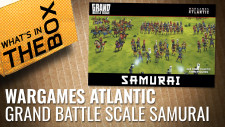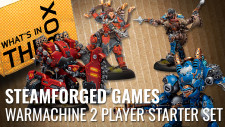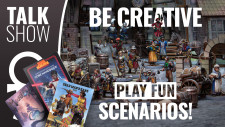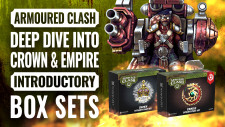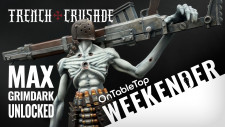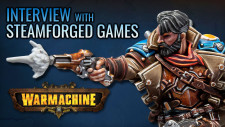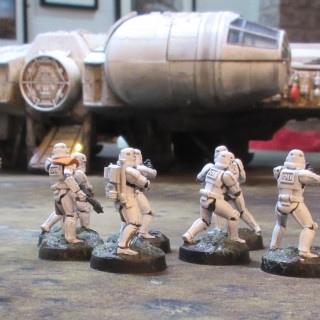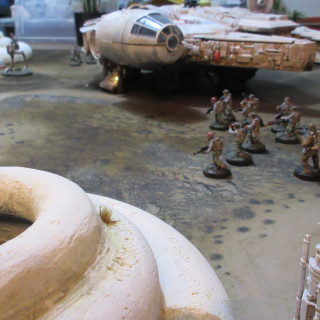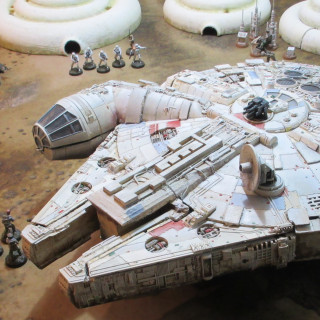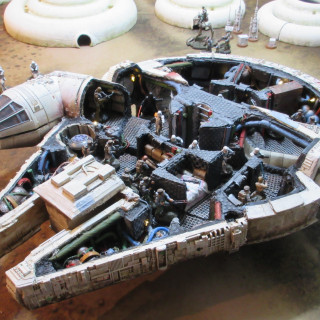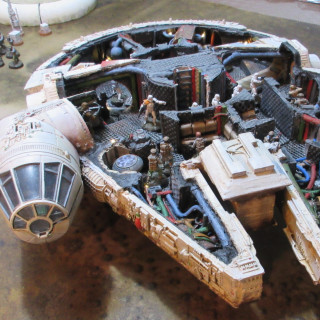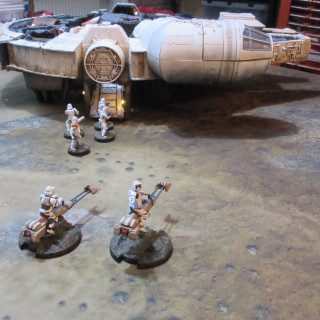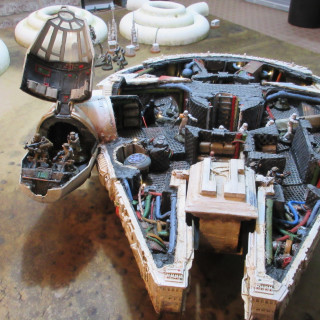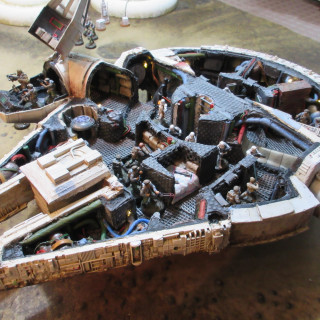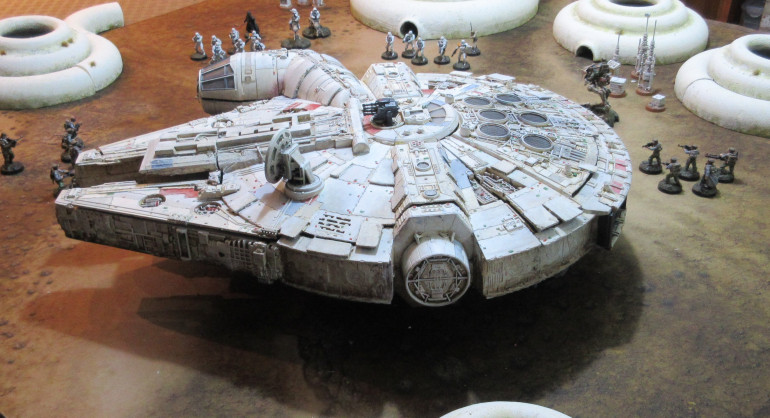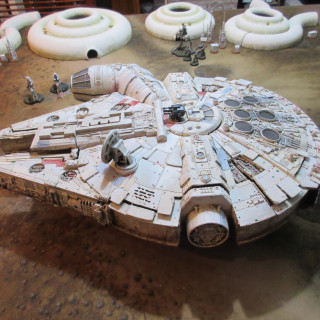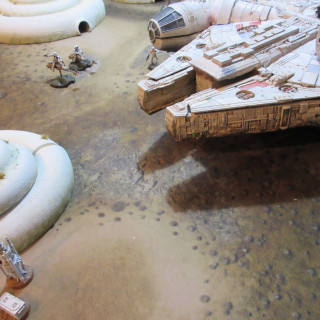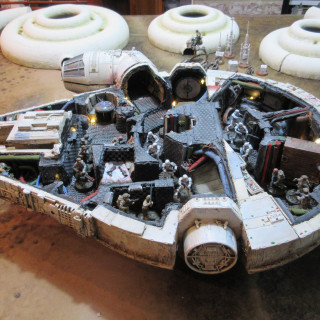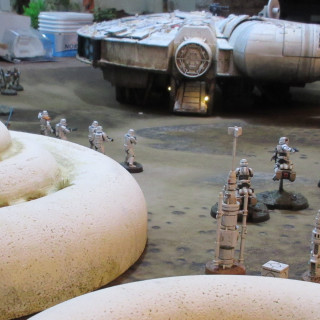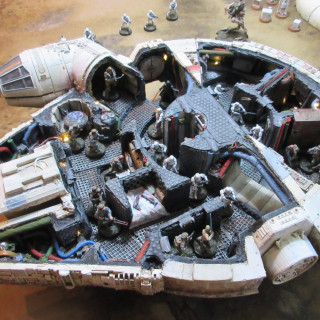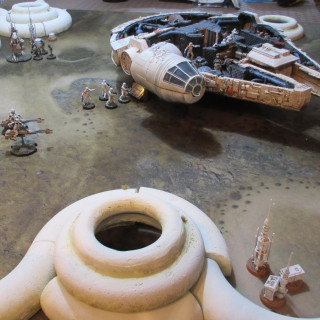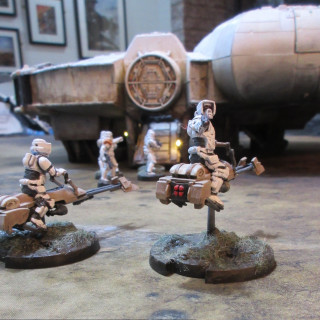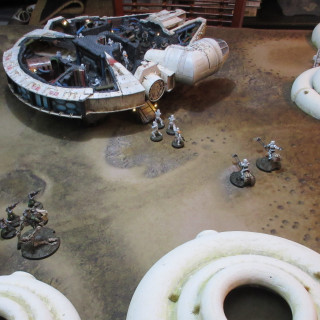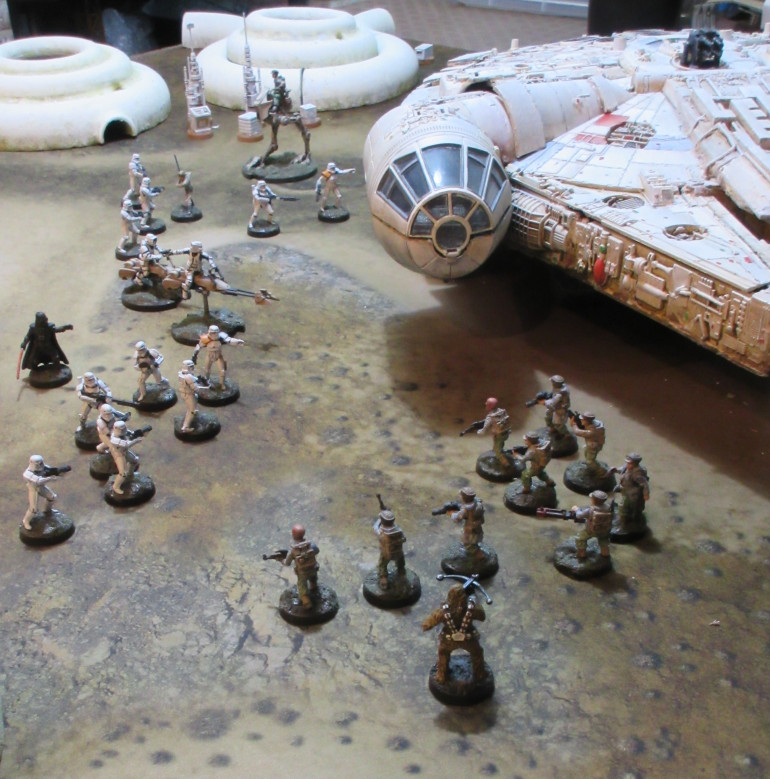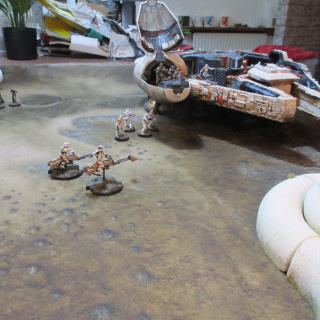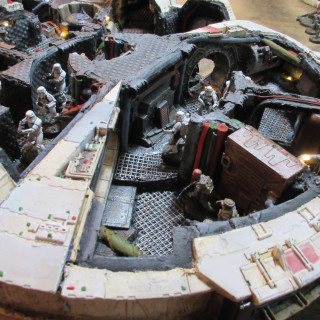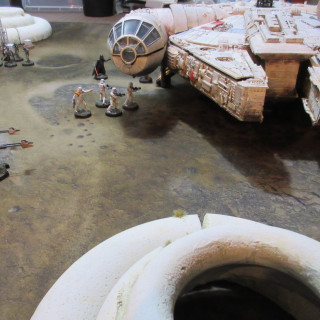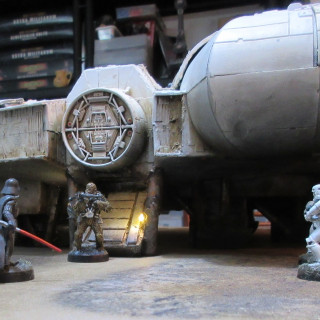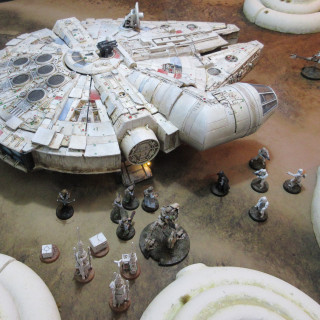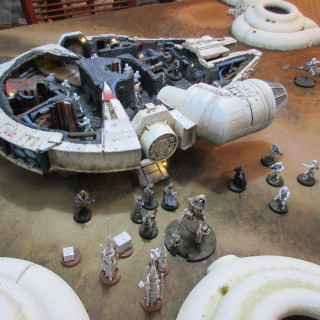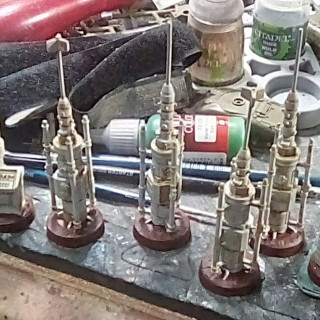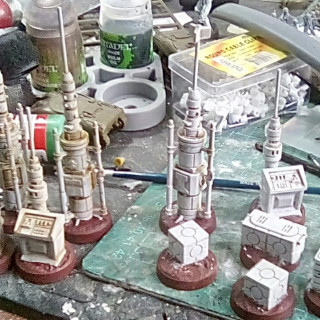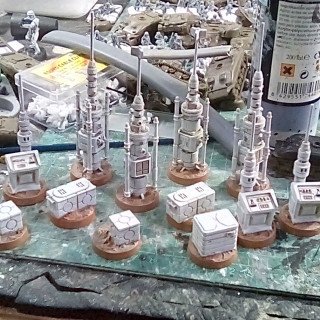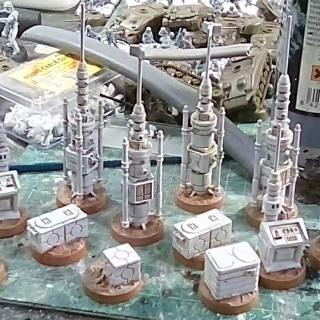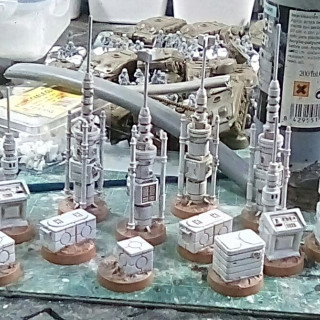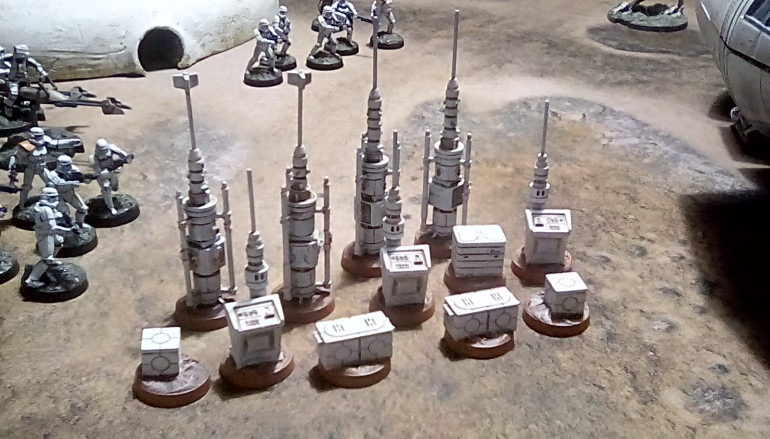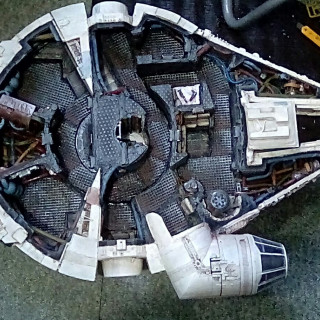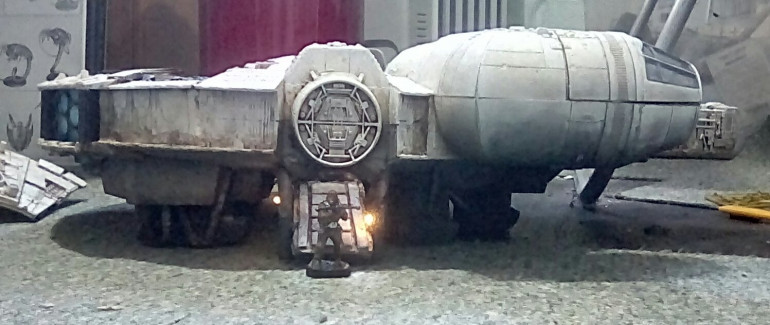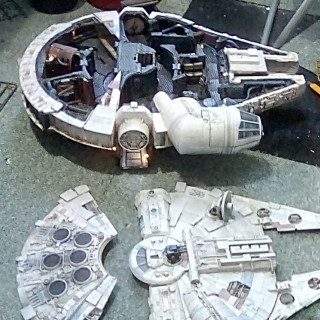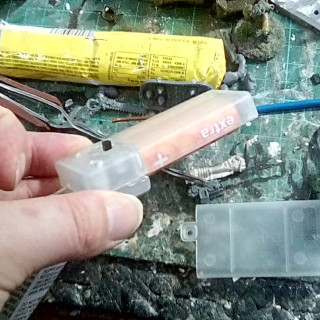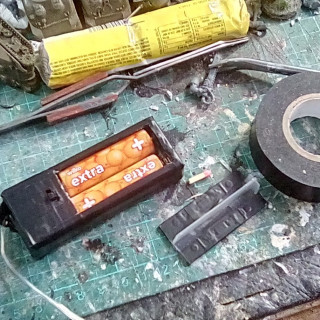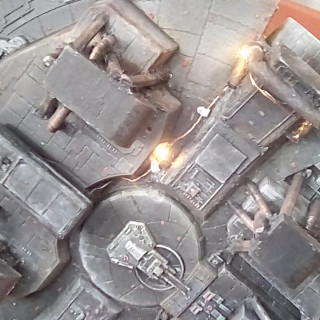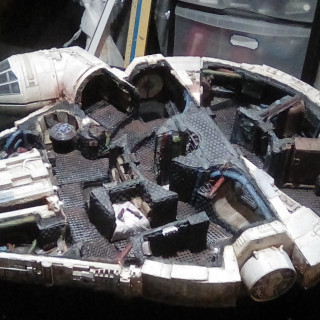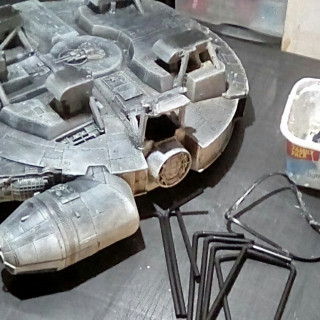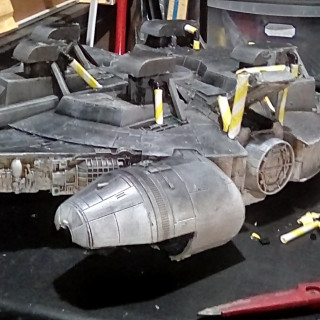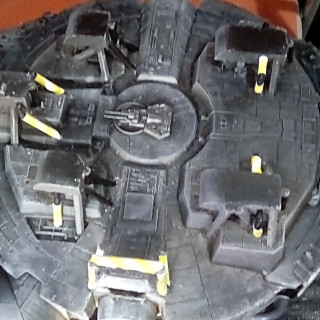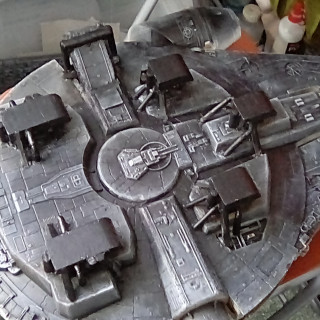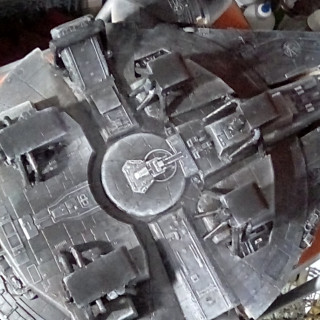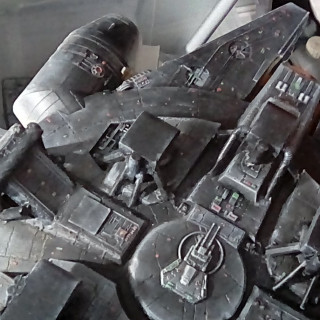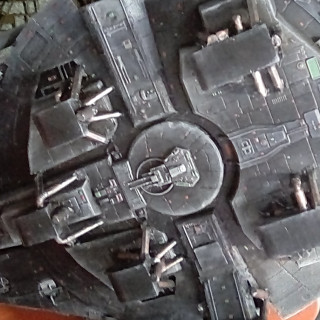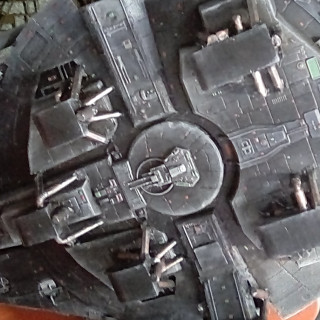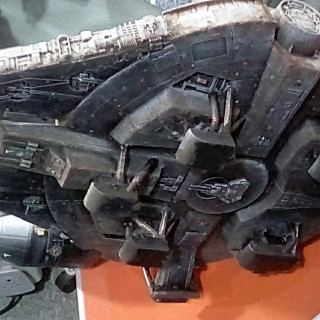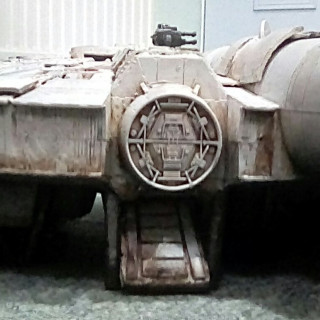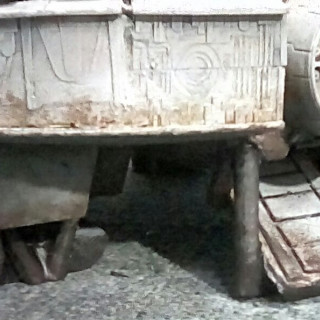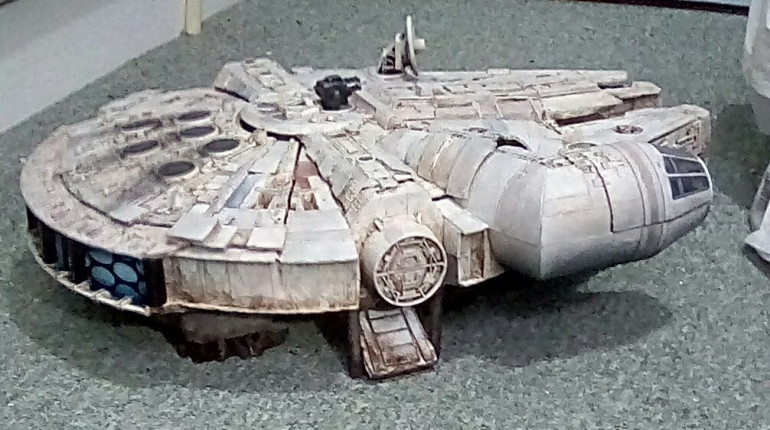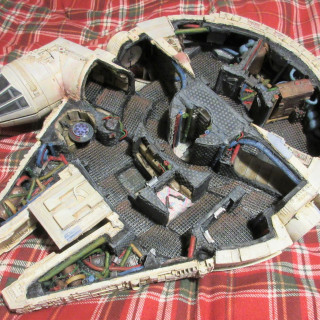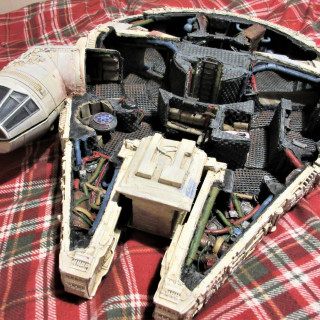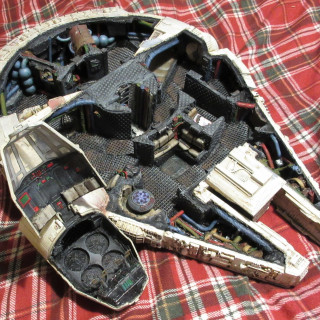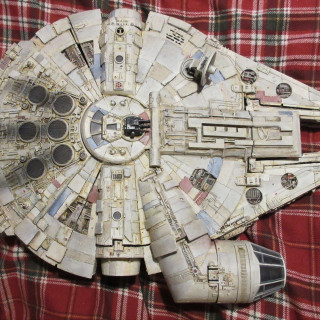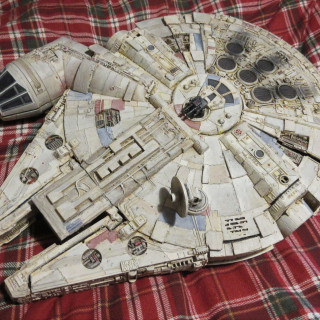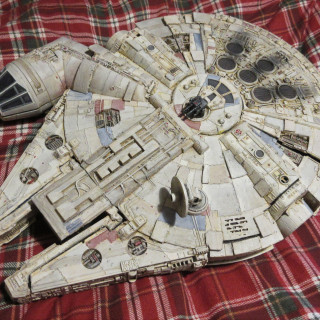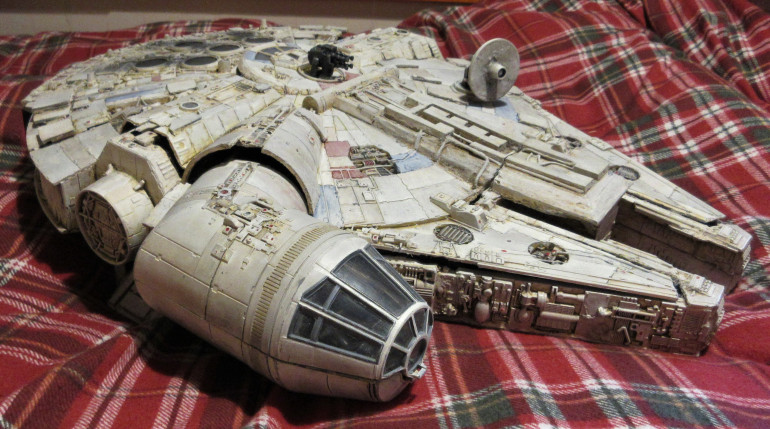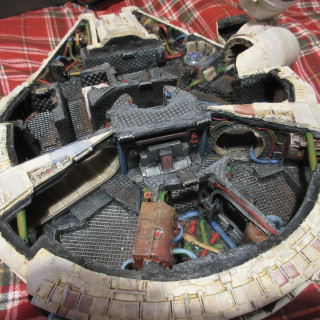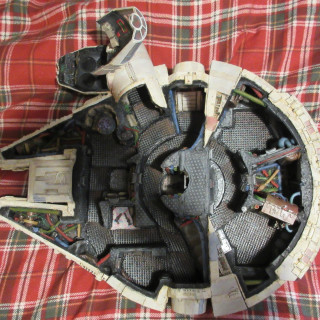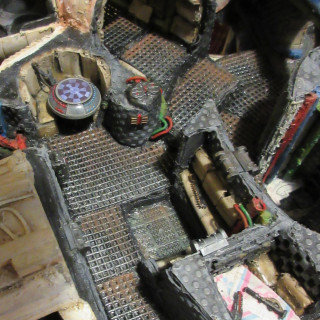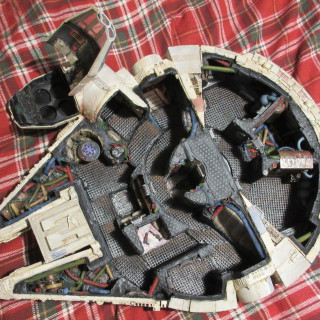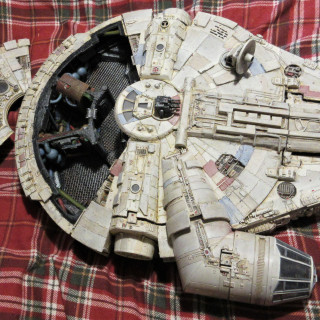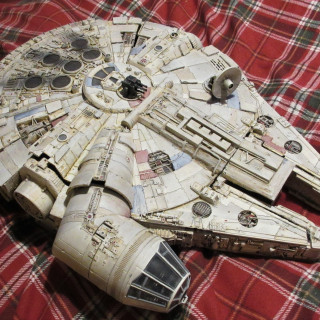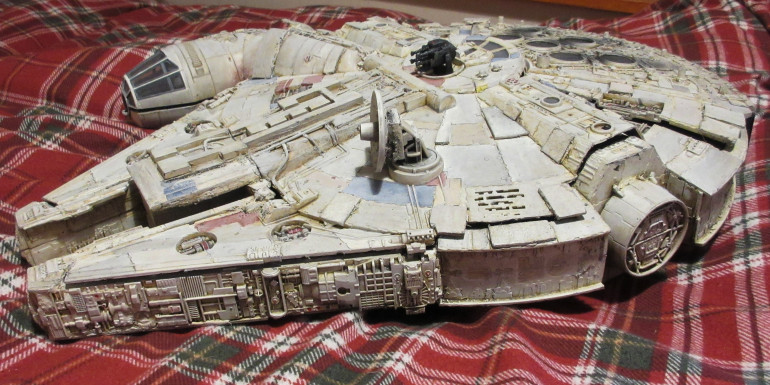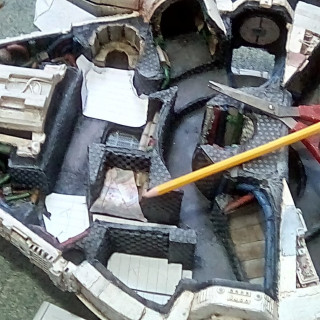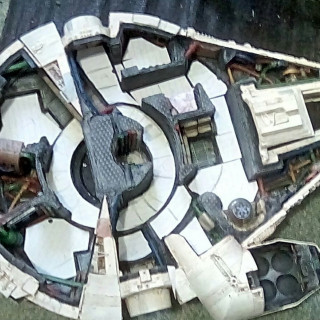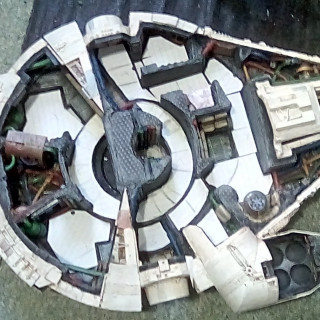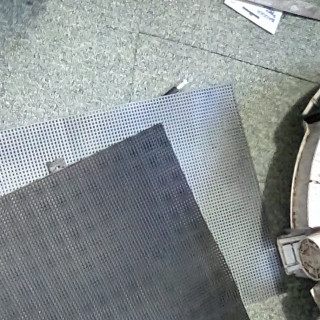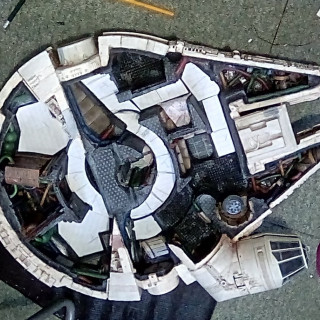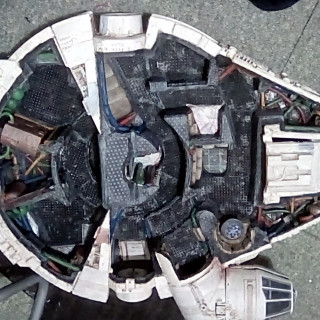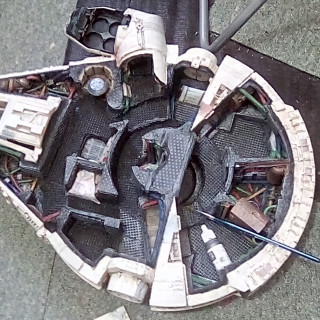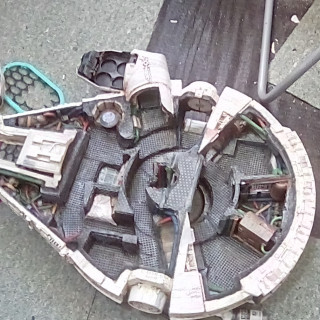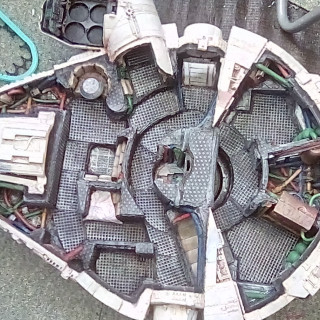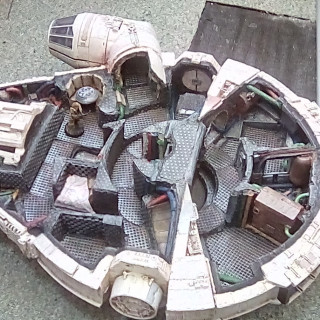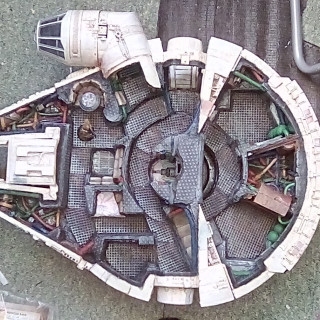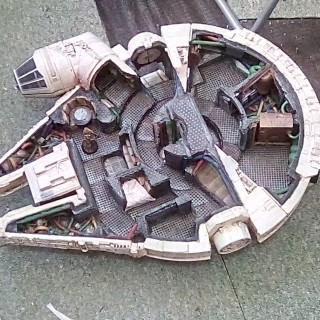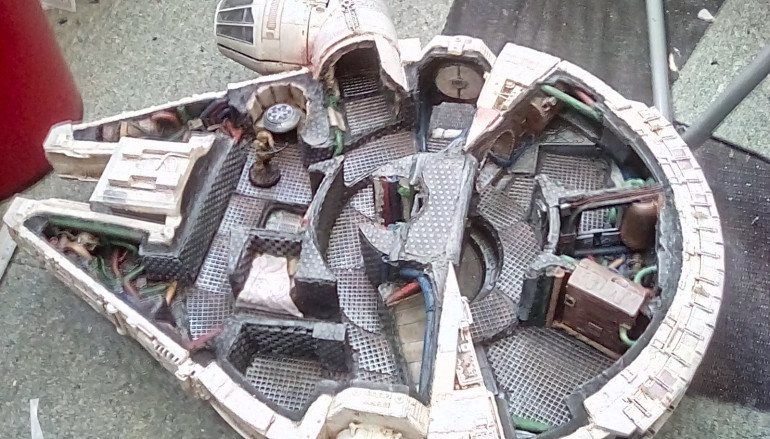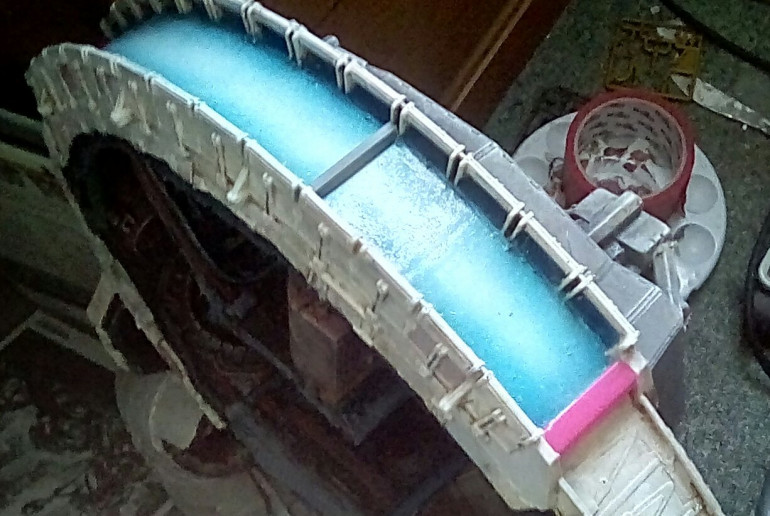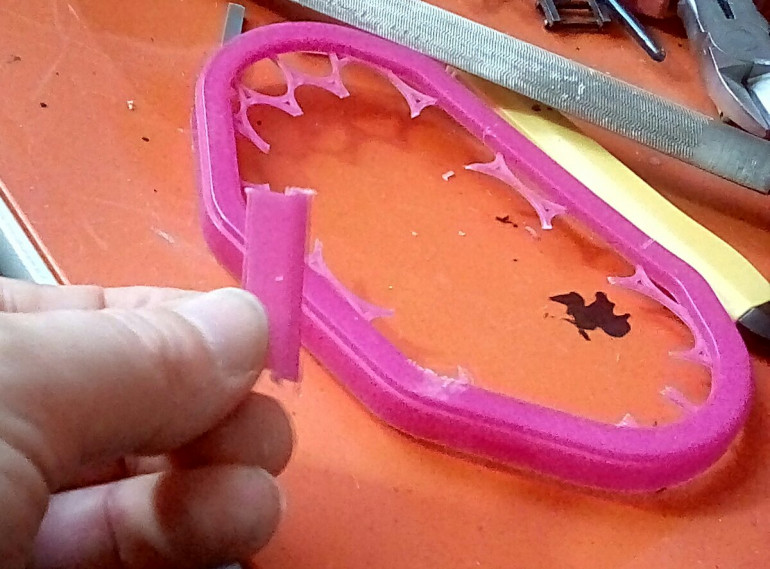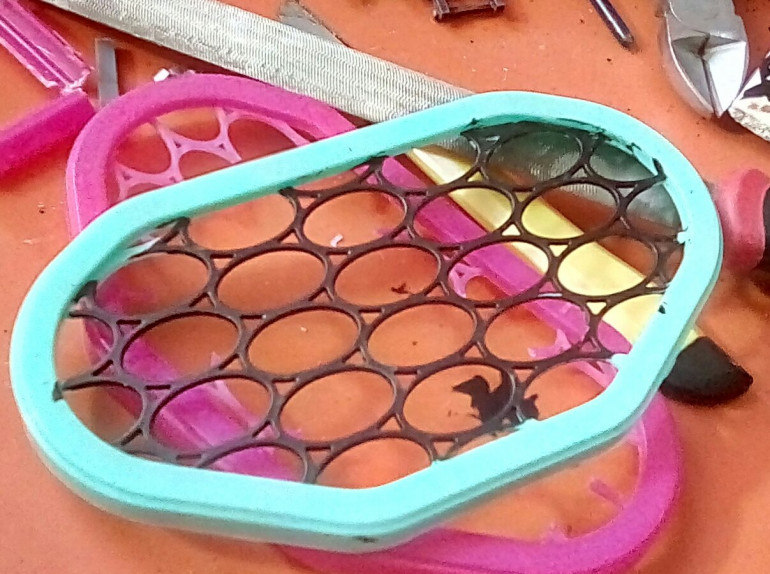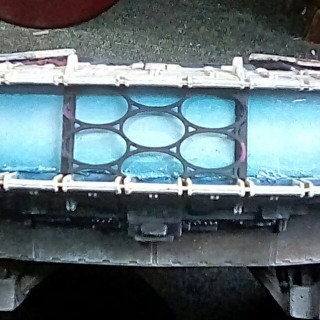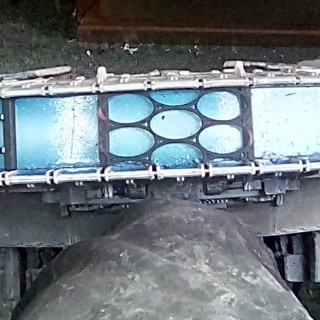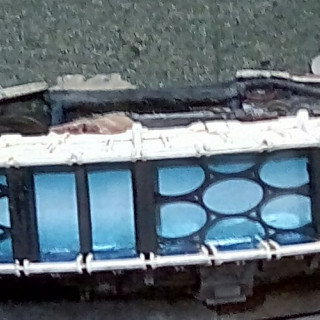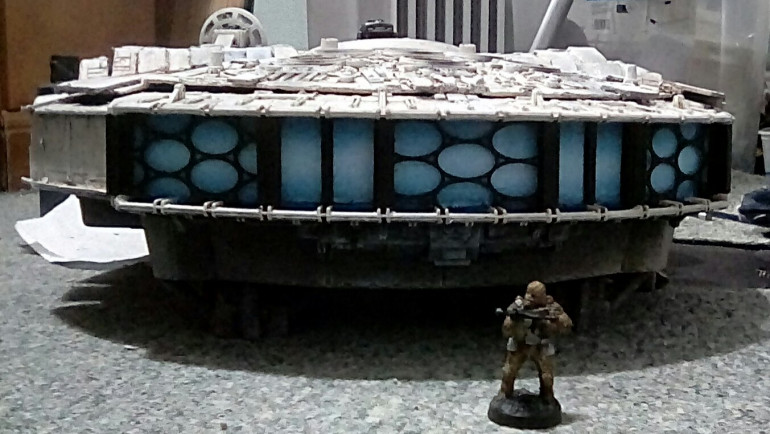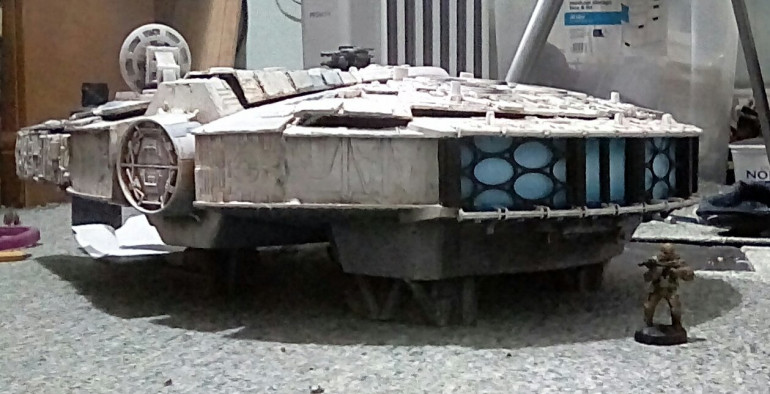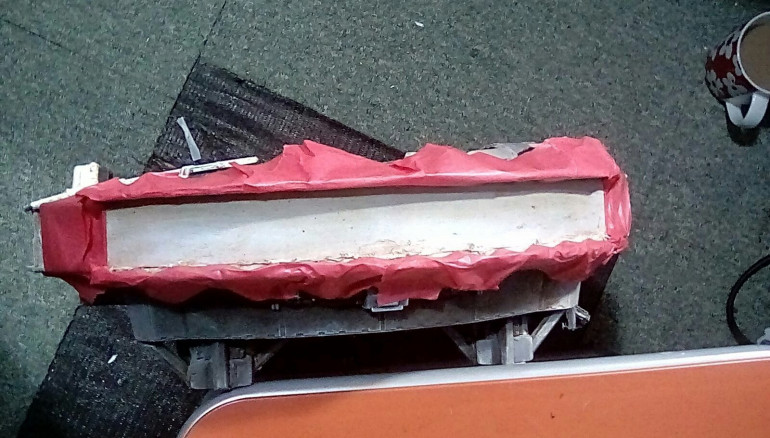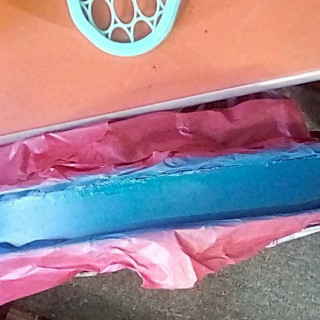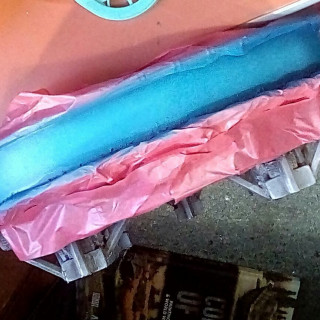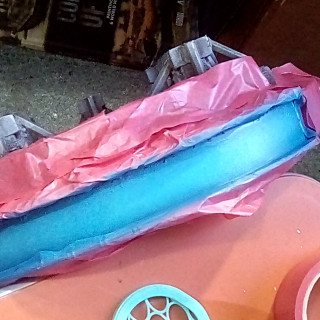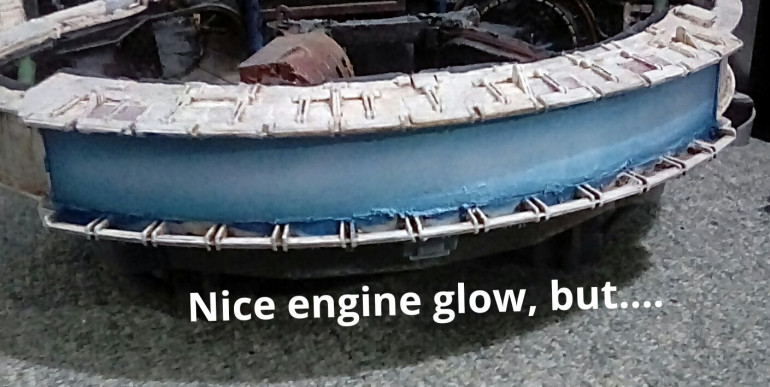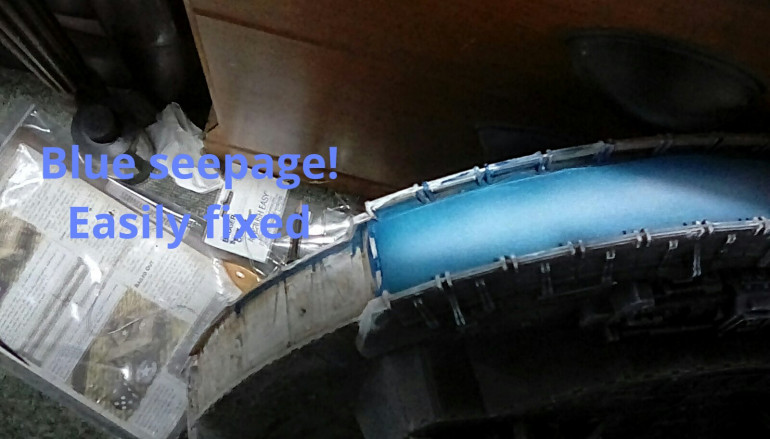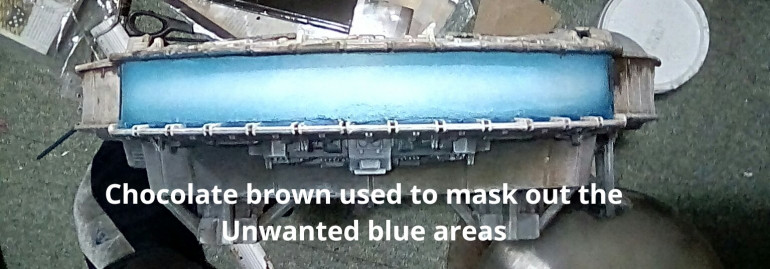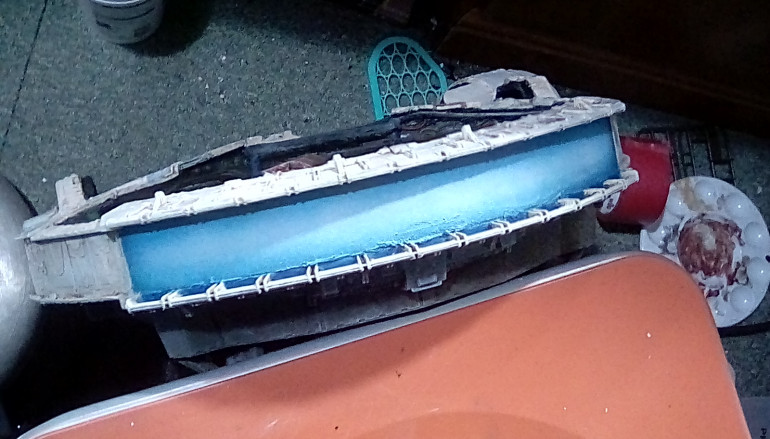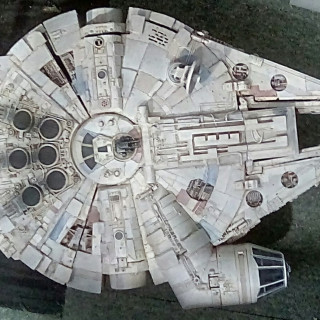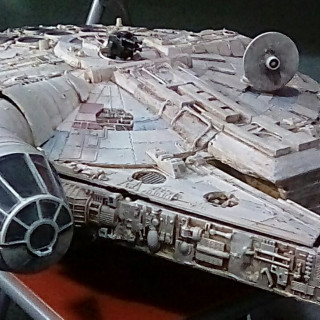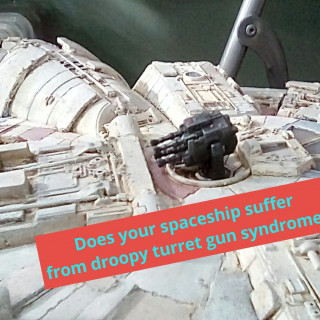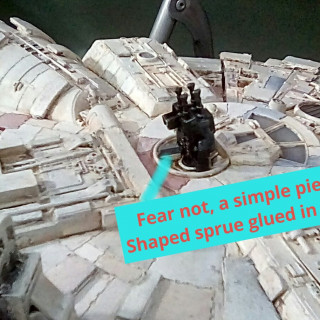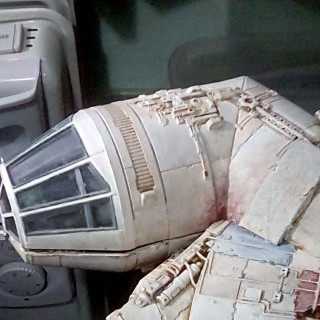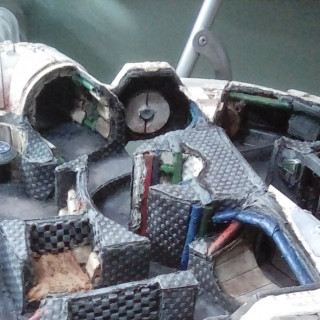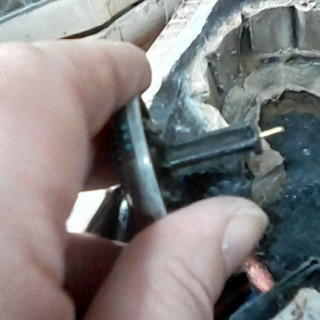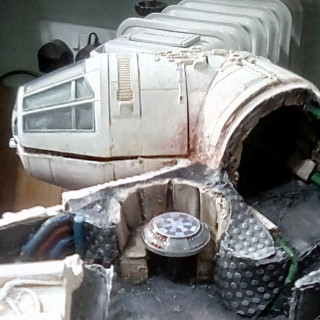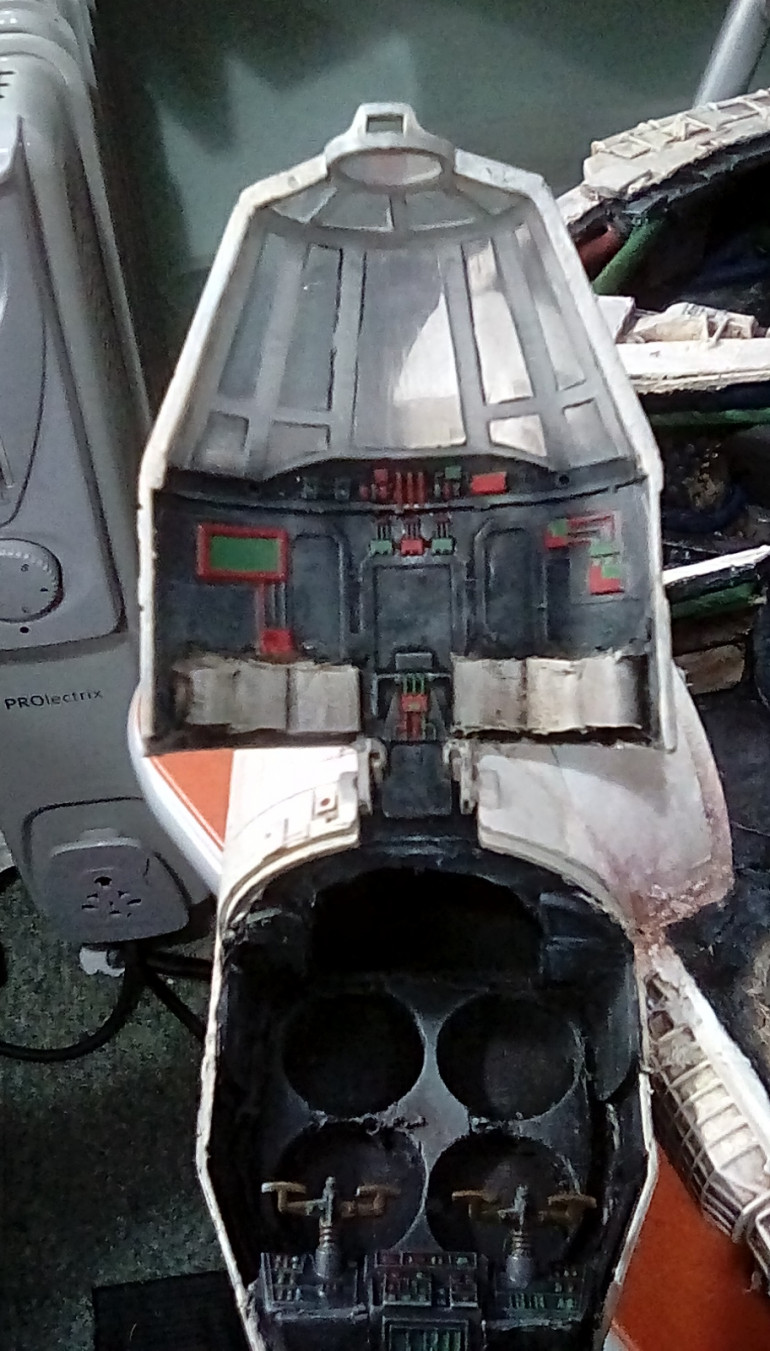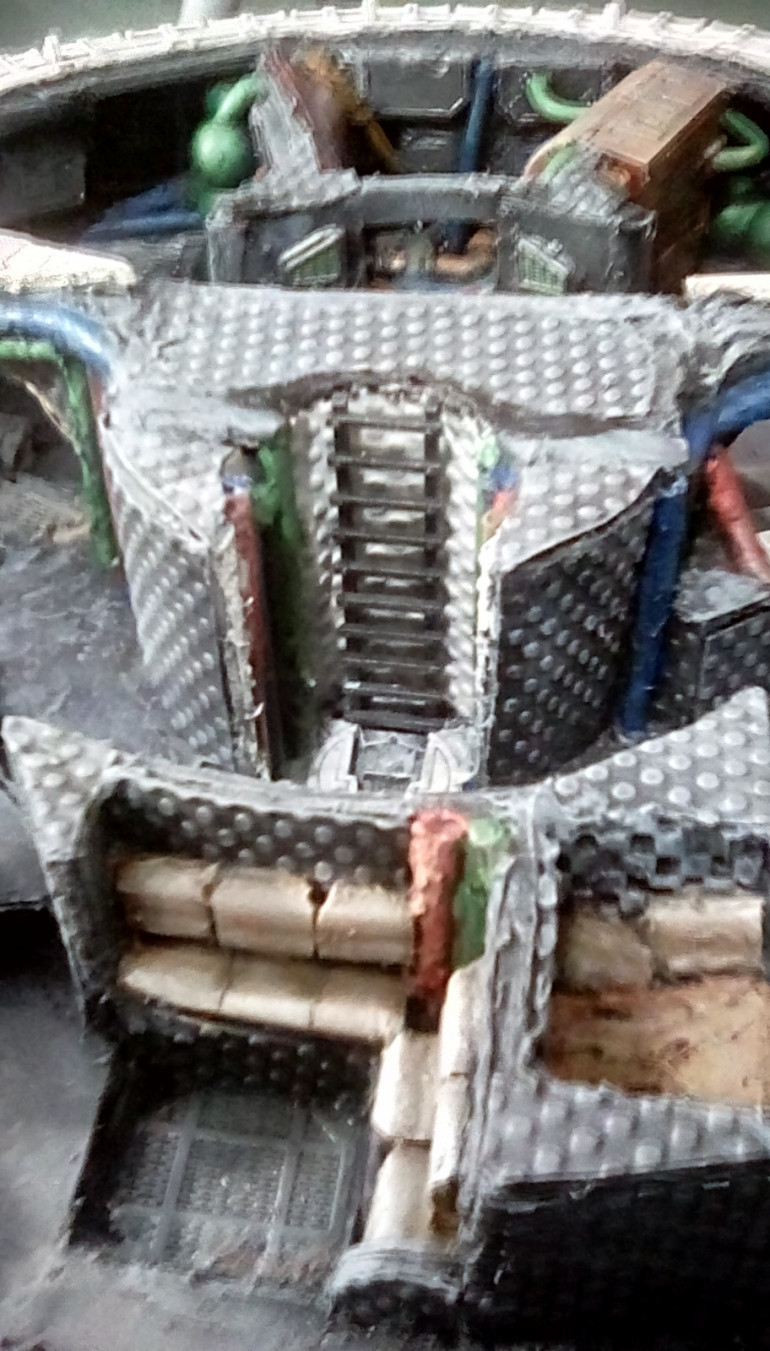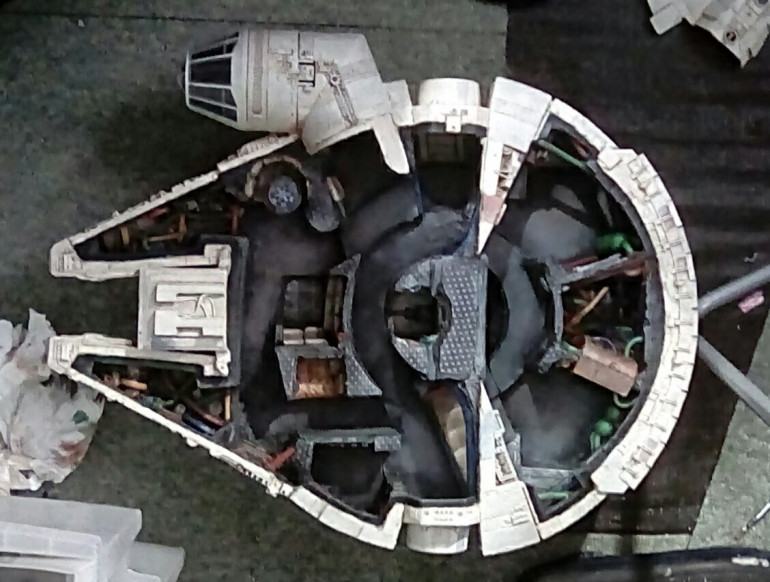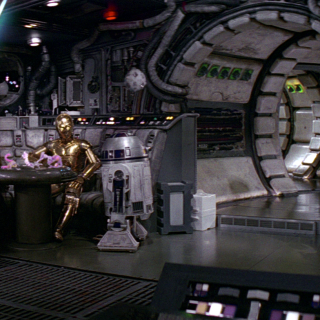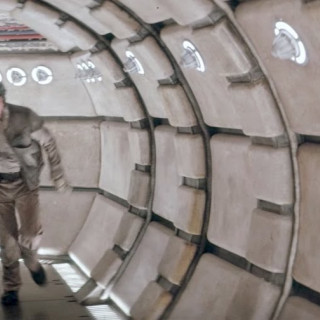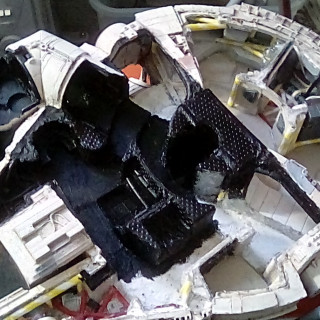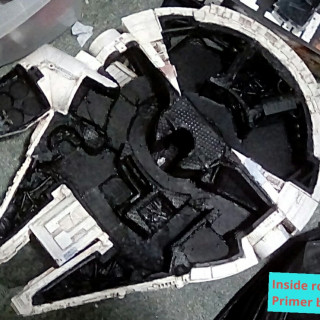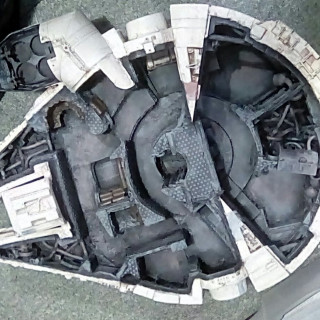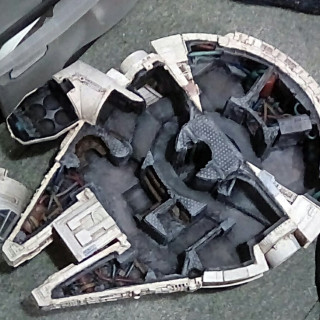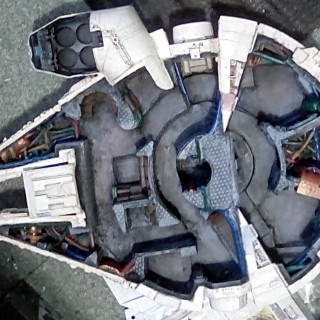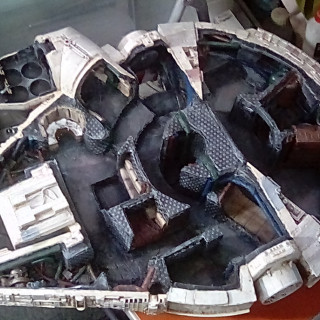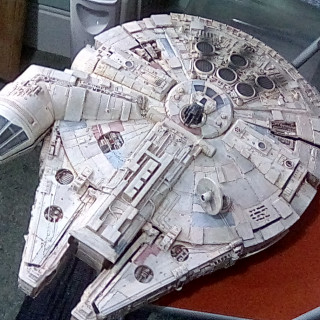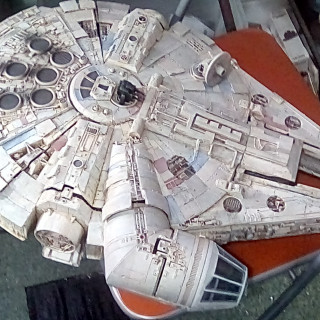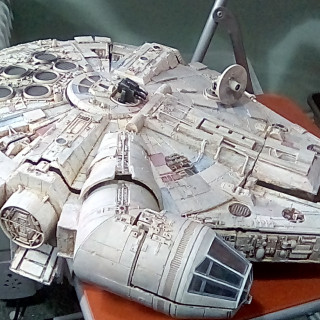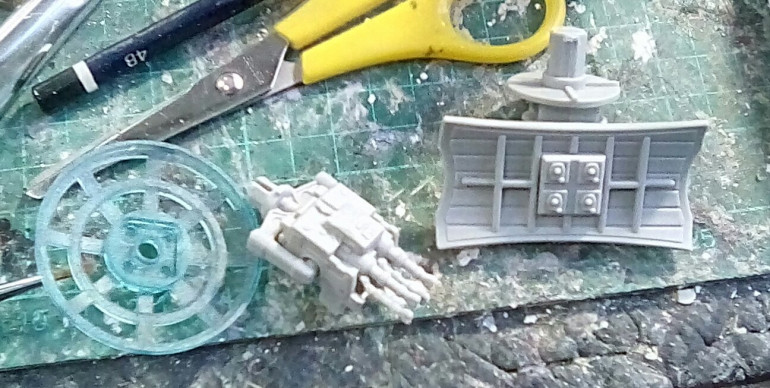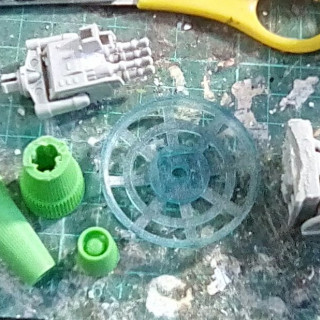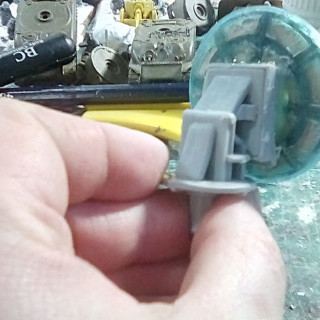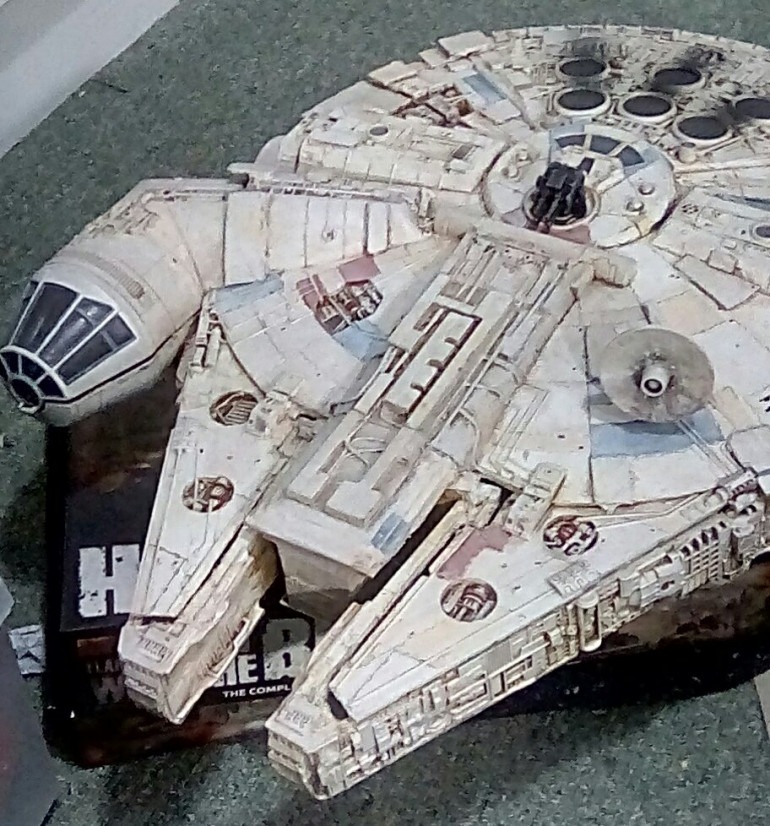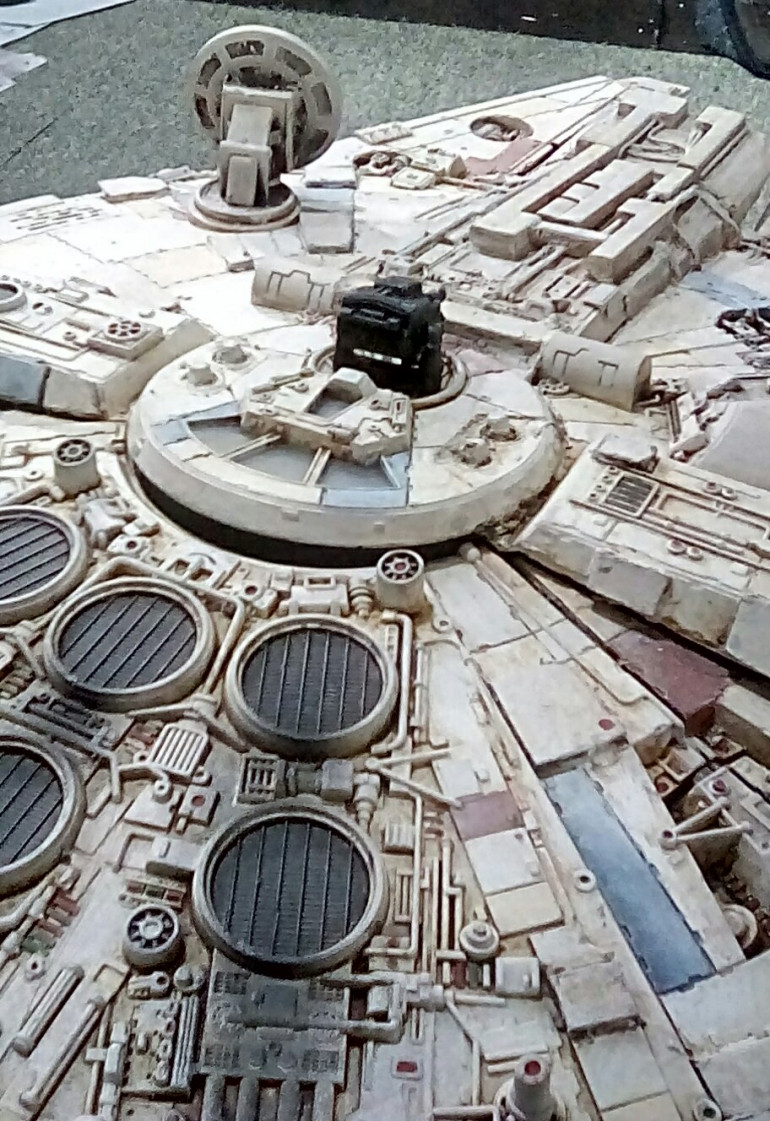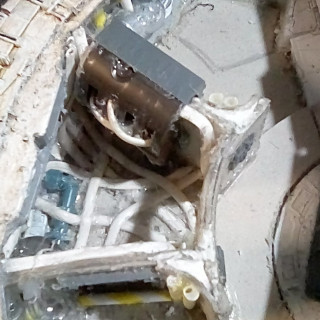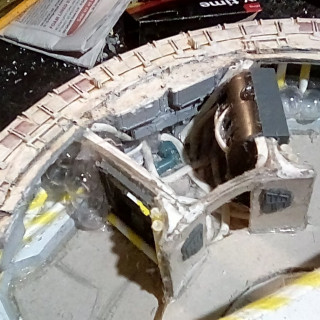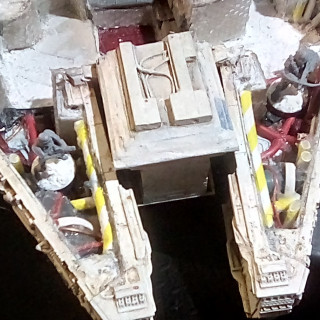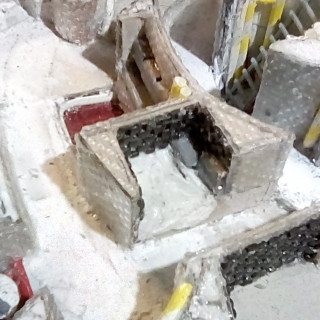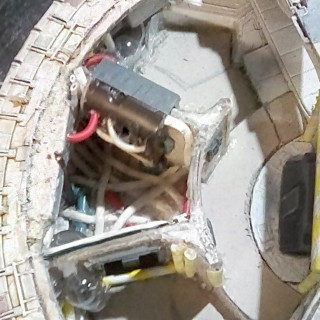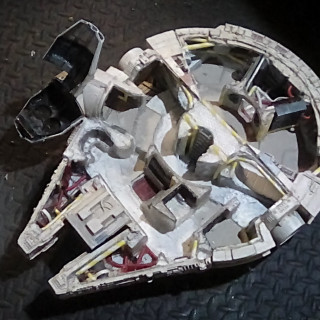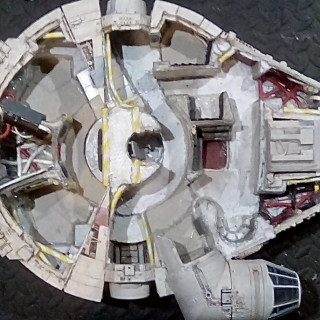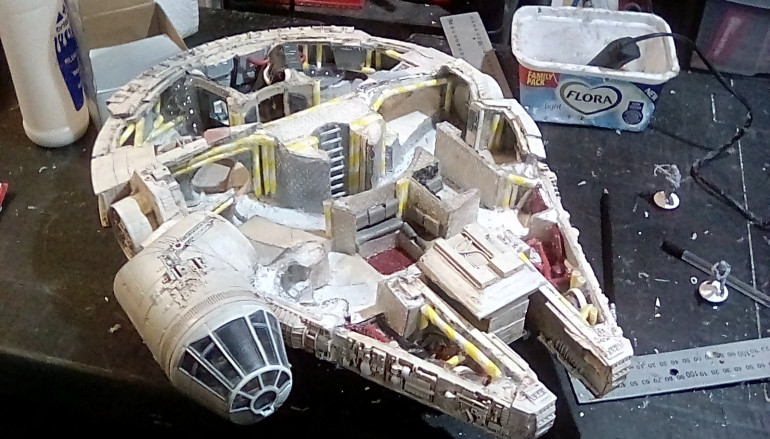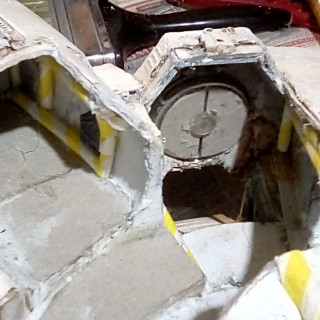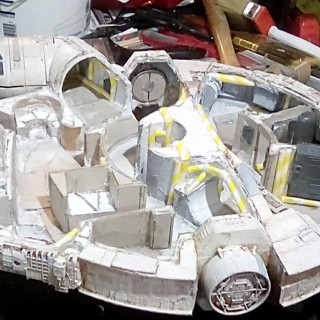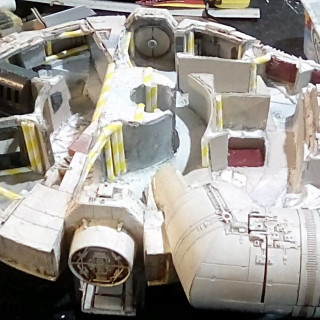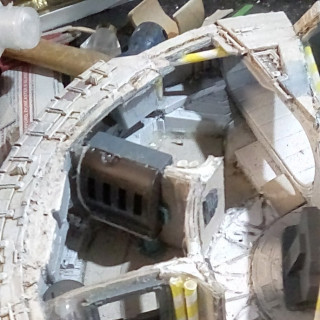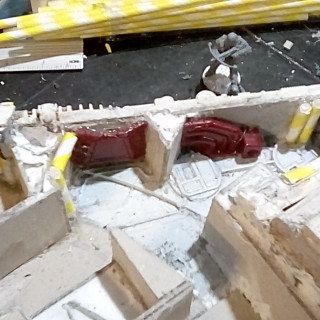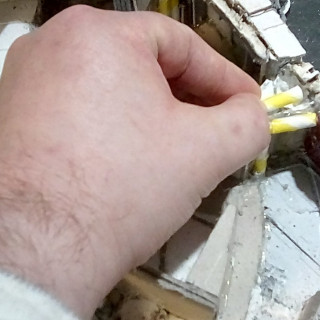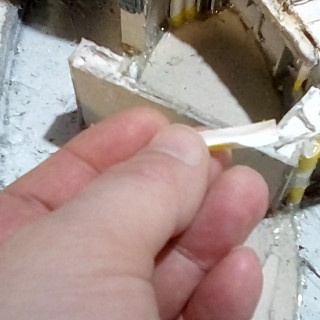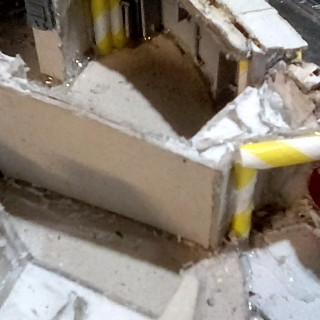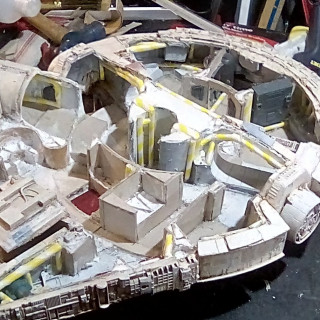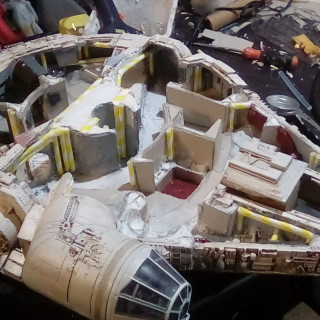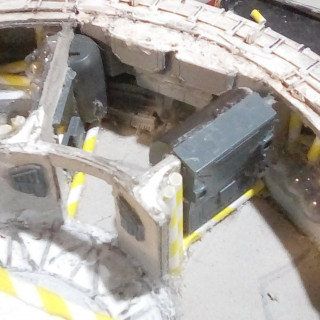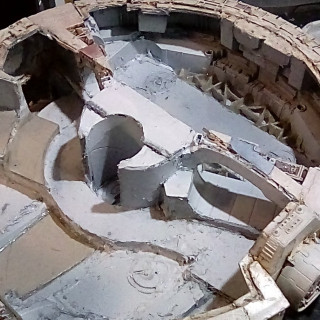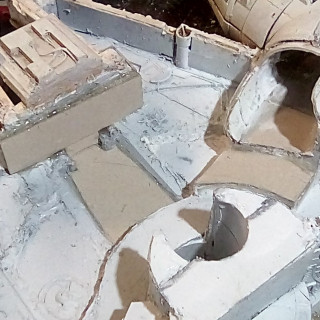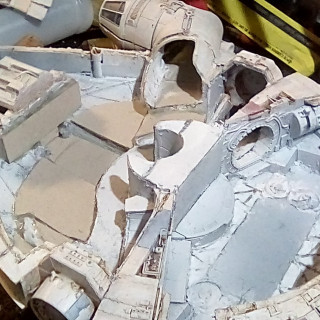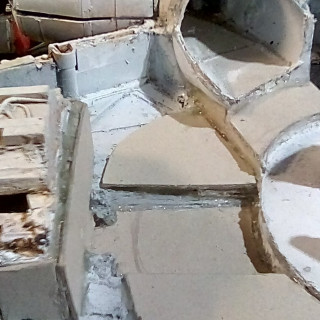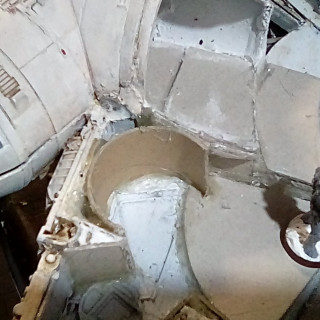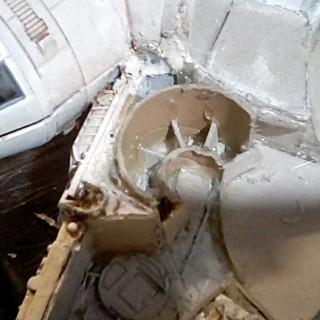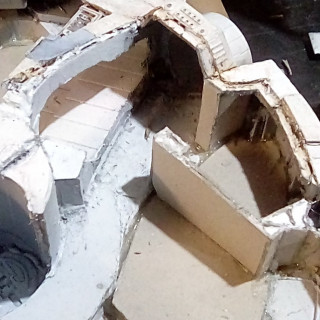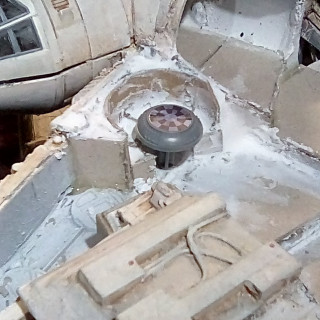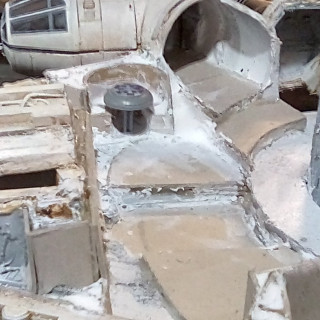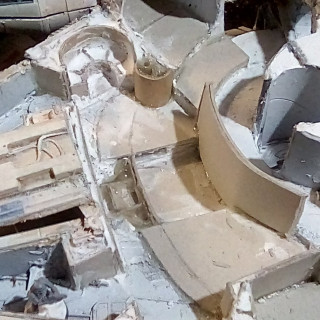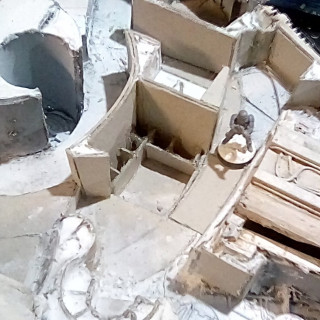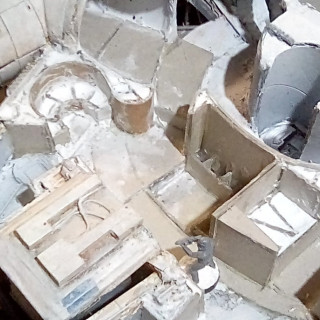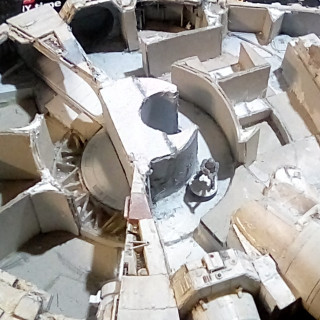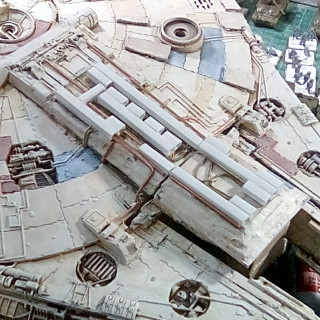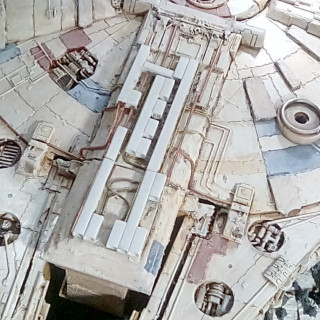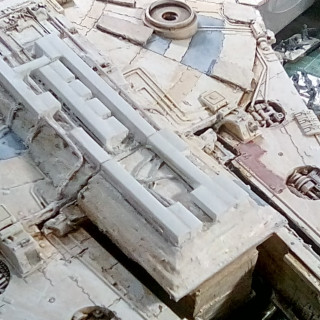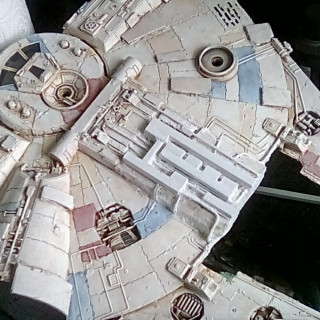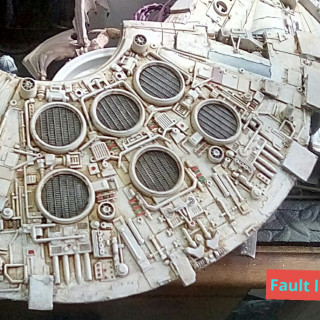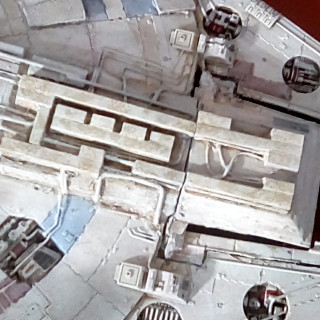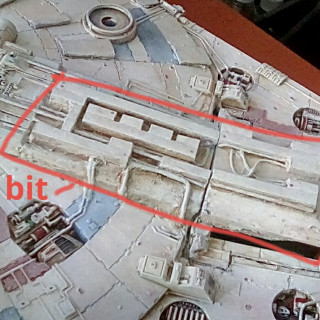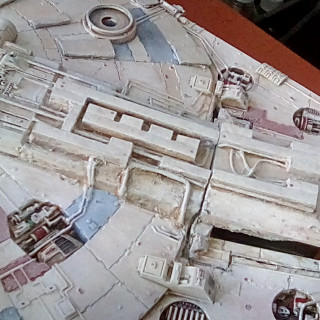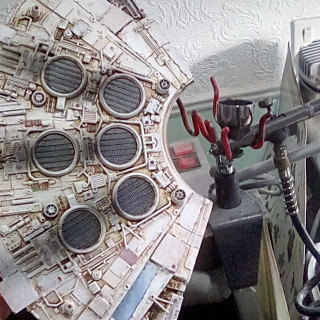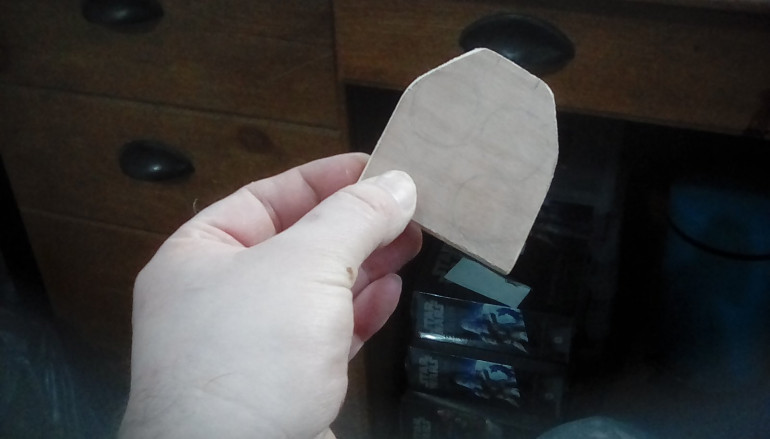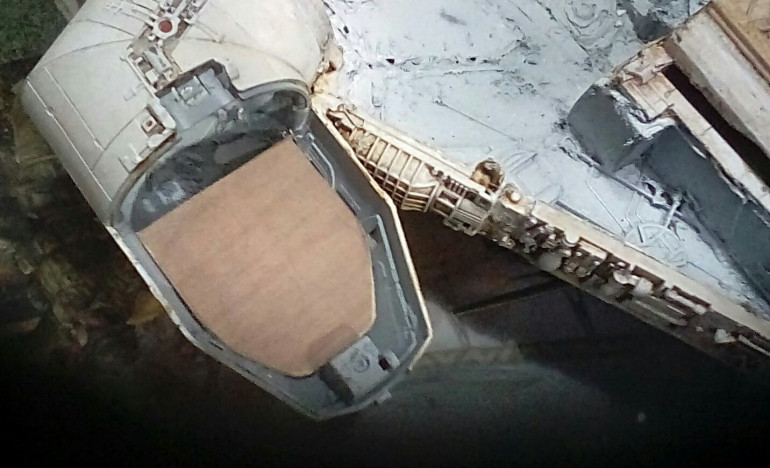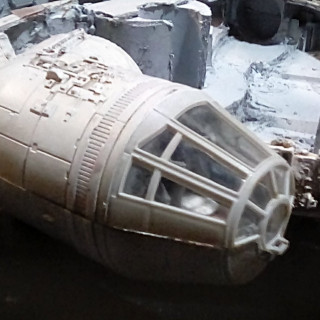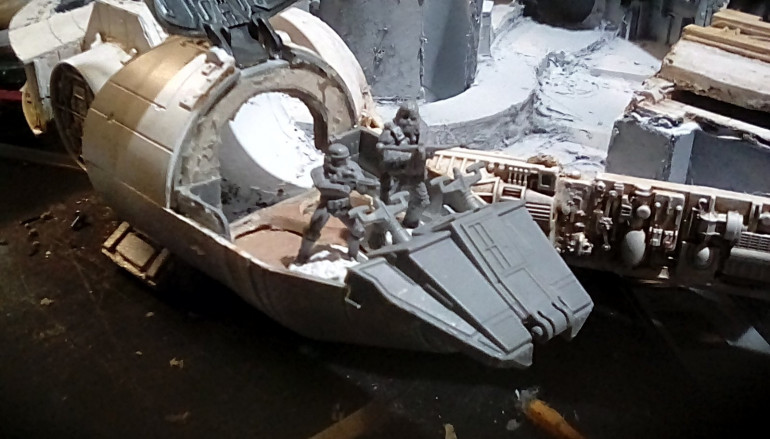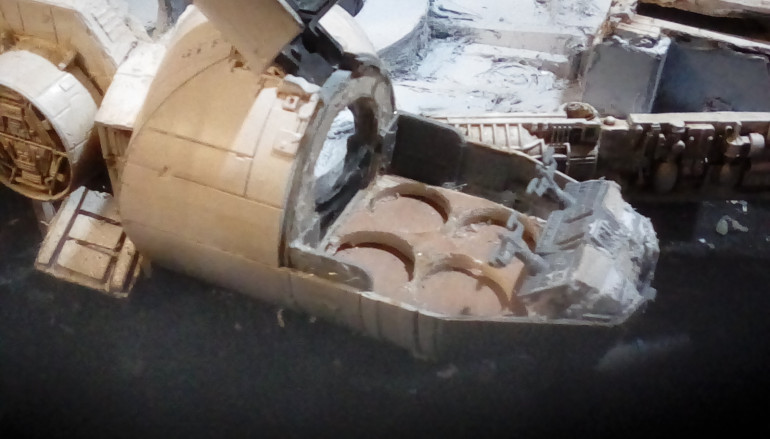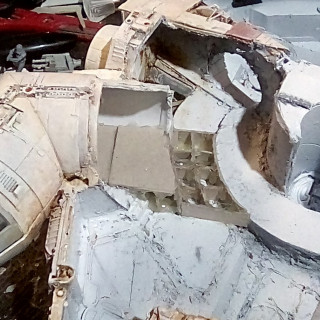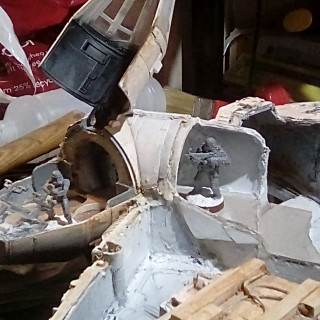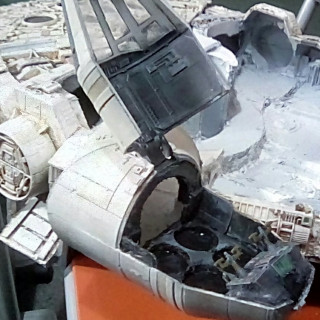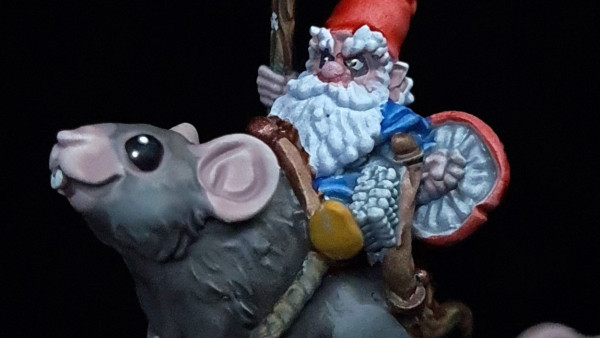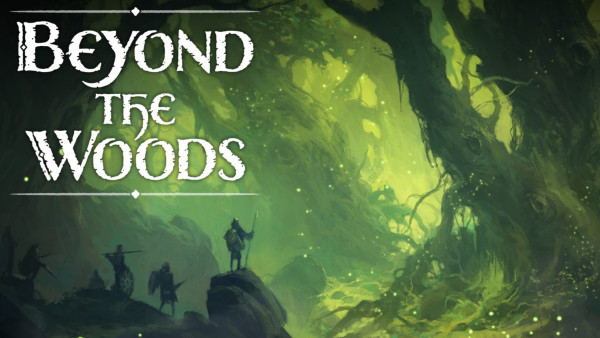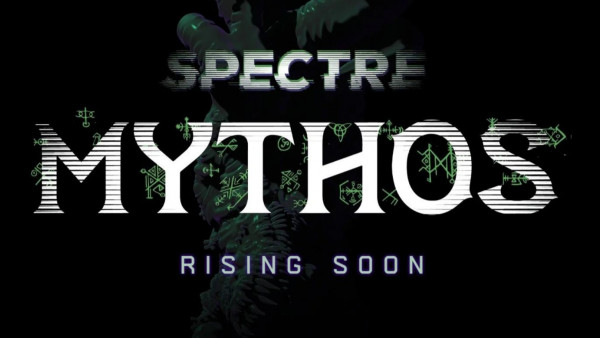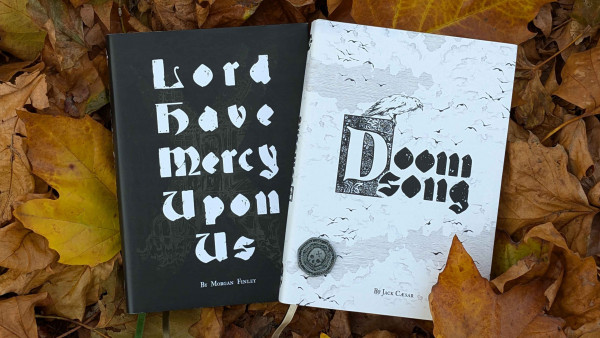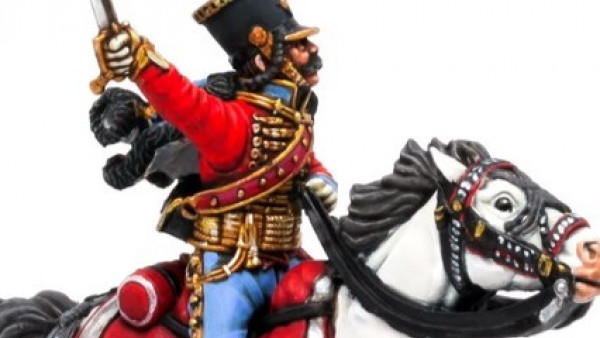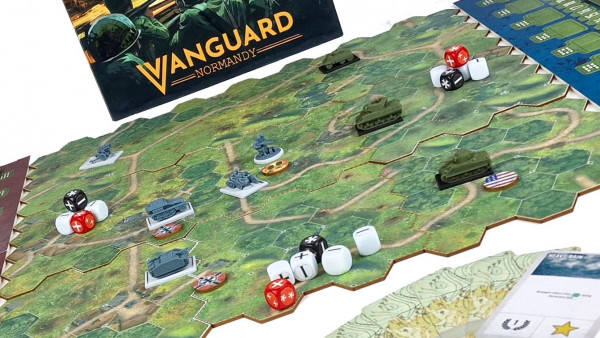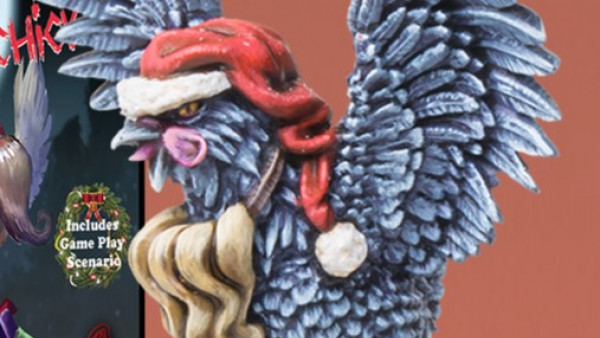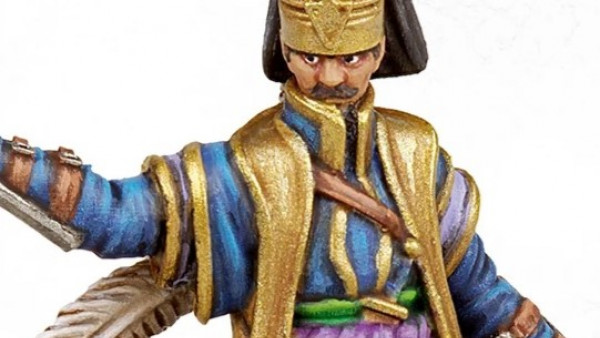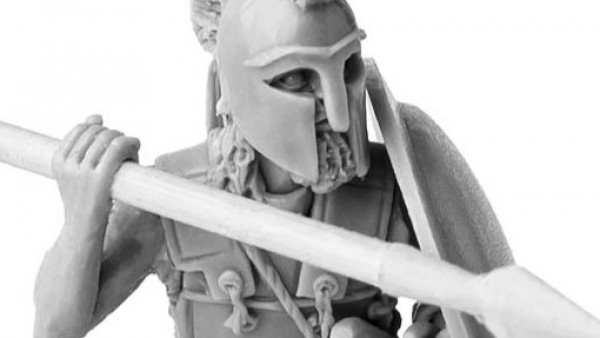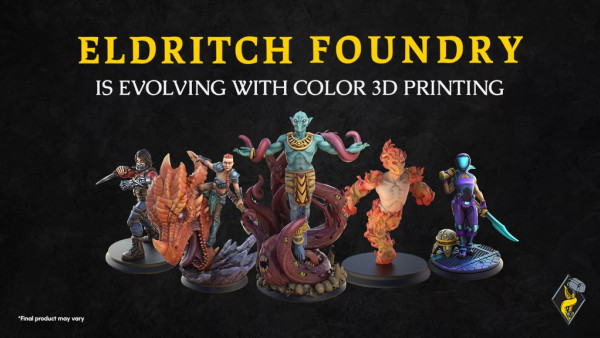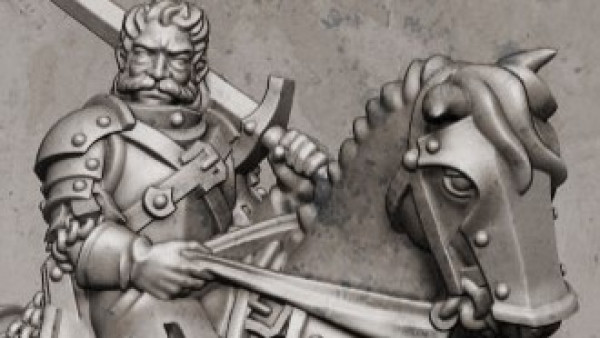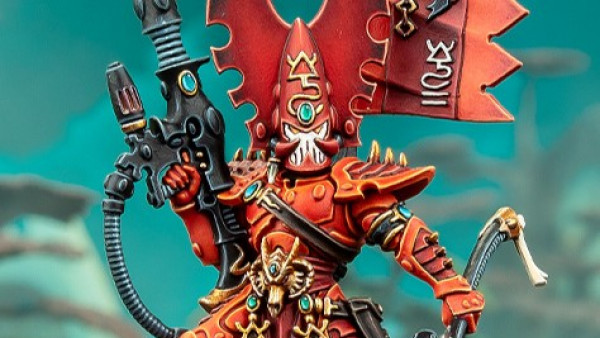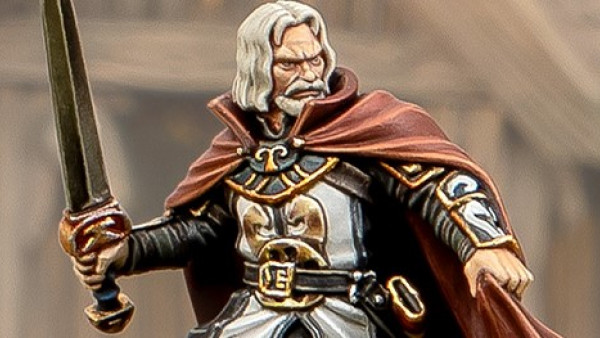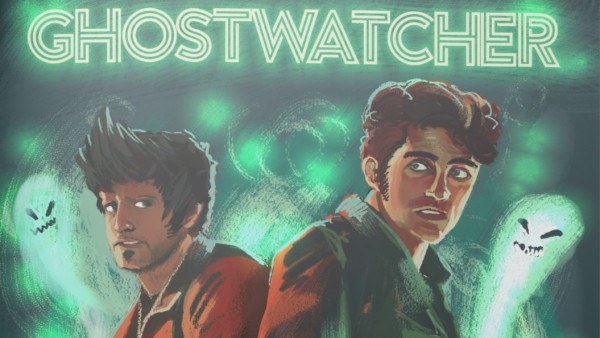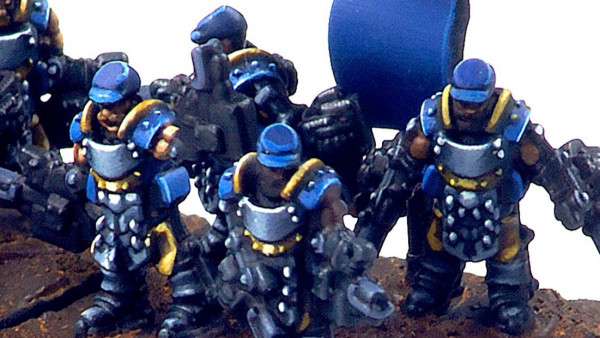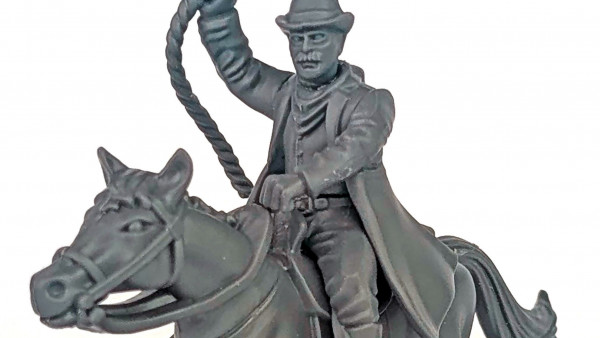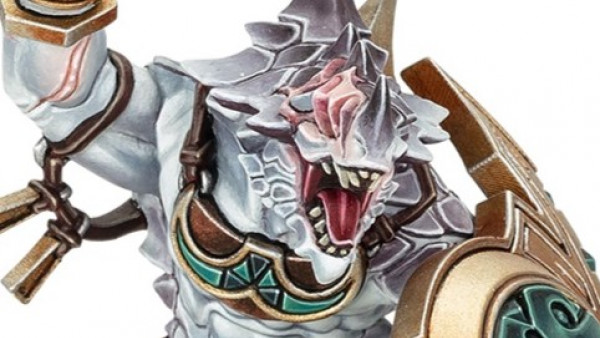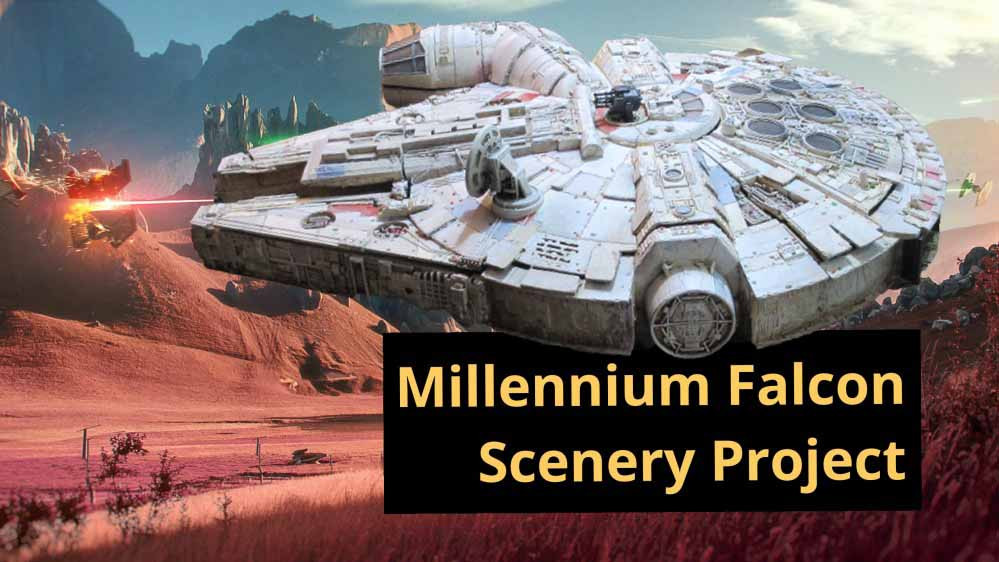
The Millennium Falcon
Recommendations: 276
About the Project
I am going to make a Millennium Falcon scenery set to use with Star Wars Legion figures, that includes internal rooms and corridors. I aim to show that with a bit of imagination and skill great results can be gotten on a limited budget.
Related Game: Star Wars: Legion
Related Company: Fantasy Flight Games
Related Genre: Science Fiction
Related Contest: Star Wars Hobby Weekend
This Project is On Hold
A Photo Gallery
There’s still plenty of work to do – the next thing will be to tweak the roof so it fits better now I’ve finalised the height of the internal room walls and magnetise it so it snaps into place.
But for you lucky folks, here’s a few photos with a better camera of my work so far…
Painting the moisture farm.
This is just a brief little scenery side project.
I’ve decided to take some decent photos of the ship with a proper camera, and remembered I had some half finished FFG scenery. It was already assembed, based and primed black, so to finish this quickly I just Drybrushed the moisture farm grey and painted the bases maroon. Once dry I used Sepia wash in the recesses, then Drybrushed the lot white. Red and green display lights were painted in to add a little colour, but this was Drybrushed white again to add a little Tatootine dust. The bases were Drybrushed orange brown, the recesses given. chocolate brown wash, then Drybrushed bone white.
Let's talk about money, Honey....
So when I started the project of turning a broken plastic toy into a Millenium Falcon terrain piece for star wars legion figures, I said my aim was to do it as cheaply as possible without spending a small fortune. So what has it cost so far?
I’m Not going to include the value of things I had lying around anyway which would have just been thrown away if not used in this project. I am renovating a house so I have lots of bits and pieces lying around, and I appreciate that if people had to go out and buy wood, tools, etc. it would cost them more, but I very much made my design decisions based on what I had at hand for free.
Here’s a list of things I had to go out and buy… I’ll come back to this and add to the list later if I have to make any more purchases.
- £10 – one broken toy spaceship from Ebay
- £2 – Two A1 sheets of grey card from an art supplies shop.
- £5 – Half a bulk-buy box of hot glue sticks from ebay.
- 50p – a pack of pencils
- 50p – a pack of straws
- £15 – Three tins of spray paint (black primer, grey & satin white)
- £2 – about 1/5 of a large gun of vallejo sepia shade.
- £5 – guesstimate of how much the various valehjo paints I used cost
- £2 half price Christmas led lights in the January sale.
Currently I’m looking at having spent about £42 on this project, which isn’t bad considering how much table space it will fill and how much joy it will bring me and my friends who love star wars.
Internal lights - Part two
Today’s entry is really just me tidying up what I did yesterday.
Bare lighting wire, wire clips and the now set solid hot glue are all primed black. Then various bits are painted to match in with the background as I see fit. A few more cables, made from off cuts of actual electrical wire, are glued in place strategically to hide and protect the more fragile copper wire of the led lights.
As the paints were already out the sides of the hull and too of the ship got a drybrushing of white,especially on any outside edges, to bring the overall colour of the ship to white/pale grey, while keeping the sepia in the recesses to create a really dirty look. I’ll probably be building up the intensity of the white gradually at the edges as time goes on by adding outer thin layer of white until I get to the colour I want.
In an ideal world it I owned a 3d printer I would be making loads of gribbly bits to add to the inside of the ship walls, as I don’t have access to that yet I will be keeping an eye out for suitable spare model parts I can add as and when I find them. The aim is to make the ship look chaotic and jury rigged, but without reducing the corridors or standing space for miniatures.
I’m not quite finished adding details and textures yet, but I ‘he got to the stage where the ship can be used in a game and look good.
Not a bad lighting set up for the grand cost of £2!
Internal lights - part One
I talked to a friend who’s an electronic quiz about how to add real lighting to the inside of the ship, and he got over enthusiastic about transformers, drilling holes everywhere and really expensive components that just doesn’t fit with the aim of this project of building the Millenium Falcon while spending as little as possible.
So here’s the affordable way of doing it….
Nowadays you can buy led Christmas lights that run off 2 AA bateries. They cost around £4 in the run up to Christmas, or a quid in the January sales.
I did but a problem with the battery pack – the door to change the batteries was on the opposite side to the on/off switch, so I didn’t have a side to your to the underside of the ship. I fixed this by gluing the battery compartment closed then cutting a new access panel on the other side with a dremel.
I wrapped the battery pack in black insulating tape and superglued it to the bottom of the ship.
The thin copper wires can be bent to shape and wrapped around things, so I led the lights up the ramp and into the ship, following the outside wall. I had to fix the wire in place, and had initially intended to glue small cable clips in place, but superglue would just not stick to them. Neither would contact glue. I had been trying to avoid using hot glue, as I was worried it might melt the very thin wire, but it was the only option that worked. I actually nailed a few clips in place to hold the wire where I wanted it, then used lukewarm not-glue to reinforce the clips and fix the wire where I wanted. Normally I let a bit glue gun get quite hot, but I kept turning it off whenever it got too hot to touch with my fingers.
In the next part, once the glue has fully set, I will paint the hot glue, cable clips and copper wires black, and disguise areas I am unhappy with as rust or by adding more “model” cables and details over the top of the real wire.
A Dirty Undercarriage
The legs and underside need messing up a bit to look like the dirty and grungy Millenium Falcon
First I managed to find some of the old time of plastic bendy straw. These are quite rightly no longer sold in the UK due to the environmental damage they cause, but my local gaming pub let me have a few they still had. I cut these down to add corrugated pipes to the legs – note that my earlier trick of filling paper straws with hot glue to strengthen them does not work with these as the plastic straws will just melt. Instead they are packed with the unused straw offcuts, with just a blog of hot glue on each end to fix them in place. I
Some of the paper straws I had left are used as sleeves to reinforce the straight sections of the plastic straws, and to wrap around any of the pencil woods I used earlier that I think will look better round than hexagonal. Then all the new material is primed black, and using a make-up brush Drybrushed mid-grey to bring it into line with what I’ve already painted.
I also added some dark shadow to the recesses of the hull while I had a black primer paint brush in my hand. I use flat red and sick green (valehjo paints) to add warning lights and stop the hull being featureless – the colours are subdued due to dumbfounded overblack, as I don’t want them too prominent from a distance.
The pistons on the legs and ramp are Drybrushed gunmetal grey, stippled with rust effect and bronze paint, then given “scratches” with a shinier natural steel paint (logically these “scratches” should run vertically, but quick horizontal lines always seem to look better).
Typhus corrosion is a GW technical paint I have never used before, but I had some (I think it came free with a partswork magazine) and it work well at adding grunge and texture to the bottom of the legs and leading edges of the side s of the hull. I just stippled off in with an old brush (which the paint finally killed off – don’t use your finest sable brushes with this stuff!)
Finally I use black paint to add shadow where the pistons meet the hull.
a few better pics....
As I’ve raided the bitz box to add some details to the insides, and given some of the internal engine parts their first coat of blue to match the outside engine glow, I thought I would blow the dust off my laptop and take some better quality pics than is possible on my tablet. The ships not finished, but I’m getting there now.
The main parts of the ship stucture are nearly done now, but there’s still a lots of detailing left to do in order to hide rough edges and add interest.
THe next couple of entries will be some more work on the legs, and then seeing if my plan for installing really cheap but effective lighting will actually work.
The internal floors
Next up is the simple but messy & time consuming stage where the cardboard floors and corridors get upgraded to look like metal mesh.
first make.paper to templates of all the flooring and corridors to be covered remembering that the paper needs to be able to lie absolutely flat.
I had picked.up 2 a4 sheets of plastic mesh from a local craft shop, the sort used to sew tappestries. As they are white I prime.these and then paint one side black with spray paint. Spray paint adheres much better to this kind of plastic than brushed on paint. Once dry I make the mesh flooring pieces by cutting around the paper templates with scissors and gluing them in place with a thick gel superglue. I use rubber topped pencils to push the mesh down in place, rather than my fingers, as some glue will leak through the holes in the mesh. Once dry the black.paint is touched up.by brush where the glue has seeped through.
The mesh is then Drybrushed with gun metal grey to pick out the pattern and give it a metallic look. I chose the top left corner of each mesh panel to get highlughted with natural steel, and the bottom right corner to get painted with rust effect (all valehjo paints). This makes each panel distinct from.it’s neighbouring floor panels and helps the ship look old and rusty.
There will actually be 2 stages after this, but I won’t photograph those as they shouldn’t look any different.
Firstly, once everything is dry I will cost all the mesh flooring in a generous coating of yacht varnish. Not only will this stop mini’s bases scraping the paint off the plastic.mesh, it will help seal the mesh to the card layer below and fill any loose edges the super glue may have missed.
Then I will redo all the rust areas left too shiny by the varnish, as rust should be Matt to look realistic.
The Engines strike back... (Engines part two).
Having done the engine glow yesterday, now t that is dry I can do the rear mesh that covers the engine. In the films it looks to just be very simple upright struts, but I’m going to take a little artistic license with the design.
I had some plastic tops from a dehumidifier tub (the ones that use chemicals that pull water from the air) that I had been saving as airbrush stencils. I decide to add some of the oval mesh to add interest, as well as the expected upright struts (made from GW sprue peices) and some side pieces to make it look better where The blue glow of engines meet the side of the ship.
The arts are prepared black, given a coat of Matt varnish (so they will contrast with the gloss varnished blue engine glow) and once dry are superglued in place.
I use more of the prices cut from the sides of the dehumidifier tub tops to wrap around the sprue struts – this ensures that the mesh cannot come loose over time.
I’m pretty happy with the look of the rear engines now, and will move into doing the internal floors next.
Start your engines....
Although my Millenium Falcon is landed with it’s feet and ramp down, I have decided to paint the back of the ship to show the engines fired up – may be the engine is being turned over prior to take off! The engines are normally shown as blue (except in Bespin, where they glow pink for some reason) so I planned to use my airbrush to create the graduated blue flash going to near white in the centre.
I had a few problems with the palest ice blue and white paints. They were both very thick paints, and I had to use a lot of thinner to get them to go through my airbrush. They were so thin that instead of staying where sprayed unknown to me they ran down the sides of the painted hull.
this is not that major a problem – there are few problems with paint that cannot be rectified with a bit more paint.
To finish the blue engine glow I stippled on the central white stripe with a brush, then once this had dried went over the edges of the white with an electric blue airbrushed paint layer to graduate the white edges. To get rid of the blue streaks on the hull I used chocolate brown (as it covers well on first coat) then once it was dry merged this into the existing paintwork on the hull with a light drybrushing of bone white, followed by a lighter drybrushing of off white on raised edges that would catch the light. I also added a brown shadow to the underside of the rear engine flaps. Problem solved.
As a precaution against further mishaps I have given the engine glow a quick thin coat of yacht varnish, which will also give it a nice glossy sheen as well as protecting the paint.I
Once the varnish is dry I will be able to make the covering mesh that should finish the engines off nicely.
Yet more painting on the top hull
This is really the end of the previous entry, seems there is a limit to how much content can go in one entry and I must have reached the limit.
Anyway, after using a grey wash on the top hull yesterday, today I tidied it up and got rid of the inevitable tide marks. I use an off white to dull down any strident colours that are too vivid and add edge highlighting where I think any sharp edges would catch the light. When painting individual panels on the hill instead of adding solid.blocks of colour I blend outwards from.one corner to graduate the original colour. It is important to repeat this process in the sides of the ship so the whole ship looks uniform, although I let more of the Sepia remain on the front and rear the engines where I think the ship would be dirtier.
By adding the white like this I am still allowing each individual panel to be a slightly different colour, but from a distance the ship looks nearer to the overall colour of the original ship in the films. Probably I will continue tweaking the colours of hull panels whenever I am painting other things.
More painting and details...
In this update I am going to group together a few little things I had to do to add vital details and correct a few little niggling things that have been bothering me.
First up is the turret gun. I don’t know if it was a design fault, if my be built top hull is higher than the original was, or if a part is missing, but the turret gun drops too low – shot in that position it would blow a hole in the ship. I simply glue a piece of shaped sprue into place to stop the gun dropping down too low. I could have just glued it into a fixed position, but I quite like the fact the gun can move and wanted to keep that.
I add a bit rust. I don’t want to go too overboard with this, after all this is supposed to be the fastest ship in the galaxy and shouldn’t look like it will drop apart if it goes too fast. But as a neglected and dirty ship inevitably there would be a few bits of rust here and there. I add rust in the inner corner between the cockpit and the main hull (as a man who has had many old second-hand cars, this is surely the spot where rust would appear and make the Falcon eventually fail it’s space MOT). I reason the inner airlock doors might get a lot of condensation on them, so add rust here aswell. I had already plainted the corridor to the turrets and the inner airlock the same base colour as the hull, so they can be seen against the other dark details.
My method for adding rust is to stipple on a rust effect paint (I use valehjo rust air, but applied with a old brush), then once dry stippled over it with the original colour you were covering to feather the edges of the rust. Rinse & repeat until you are happy with how the rust looks.
It was very important to me that the ship has Chewie’s halo chess table, and luckily the original toy spaceship still had this part. I cut the base down (so it’s not to scale, but as close as I can get it) and just painted the outer rim. The chequered chess board is the original sticker that I have vanished over to protect. At the moment it is just pinned in place, so I can still remove it while doing the floors later.
The cockpit roof gets some red and green display lights painted on – I paint similar lights in the rest of the ship where there are any molded details showing.
I found a resin ladder I had bought for another project. Although moulded as a fantasy wooden ladder, it looks suitably sci-fi painted black then Drybrushed with gun metal grey. Again, not glued in place yet as I may decide to paint the tube it is in to add more detail, but the dark ladder stands out well against the light background, which is more reminiscent of the film than my original colours where.
Having dulled down the bright pipes and wiring yesterday, I highlight their top edges today so they stand out against the darker walls and corridors. This may seem like a waste of time, but now the pipes have some shadow and look grimy on their undersides, while giving me that almost cartoon look of a cut-away diagram of a spaceship that I have decided I want. I’m not building a realistic diorama but a fun wargaming peice, so people have to be able to tell from a distance what each area of the ship is – without re-highlighting the pipes they just merged too much into the background. I also drybrushing surfaces that are supposed to be metal with gun metal grey – this is a vallejo paint that gives a darker finish than the natural steel I normally use.
Starting painting the internal rooms, and changing the top hull colour balance
Starting the internal rooms.
The first thing I did was look at some images from the star wars films, to remind myself what couples the top inside your f the Millenium Falcon really was. Memory alone can play tricks on you. I am going to use the to decide on the feel I want, not slavishly follow the colour scheme.
What I take away from the source photos is that the insides of The Falcon are dark and dirty – the cushioned areas area sort of buff colour, and there are indicator lights everywhere.
First I prime the insides of the ship black.
I like the sharp contrast between the black and the outside hull, so I’ll be keeping that at the edges. But black is too dark to easily see the walls and layout from a distance, so I drybush everything with a neutral grey. This also brings out the textures that I added earlier.
Now I take some artistic license and go away from the film’s colour scheme, as I need the wiring and pipes I created to stand out from the background so they can be seen from a distance. I used dark shades of primary colours, and later when I think they look too bright I dull the down with black shade (GW Nulin oil). This also helps the engineering and engine areas look dirty and oily.
Cushioning is painted chocolate brown, then Drybrushed with sucessively lighter colours until I work up to an edge highlight of bonewhite. Metal is Drybrushed with gun metal grey, and a few big bits of machinery painted cavalry Brown and weathered with rust effect paint and a bone drybrush. By no means finished, but now I can see what colours things are going to be and where I need t make changes.
Hopefully I have hit the right balance between capturing the mood of the film’s while having a piece of playable scenery that detail can be made out on from a distance – the true film colours would just be too dark and everything would merge into one dark mass.
I’ll add a few photos of the painting going thru the stages described above:
Changing the top hull colour balance
I am a bit concerned the the top Hull is looking too yellow from a distance. To fix this I use a very thin wash of 1 part sky grey paint To about 10 parts water, and apply this to some of the panels on the roof to town down any colours I think are too vivid and give them a cool grey cast. I also use this on some of the side details, just to pull everything together.
It may not show very well on the photos, but this pulls the ship into looking more grey from a distance.
Radar Dish and gun
Next up, it’s time to work on the radar dish and gun that I saved from the original toy. The radar dish is the square one from The Last Jedi, so I decide to change this to the more traditional round dish using a Lego part I had left over from another project. I don’t have a problem with the Last Jedi film like some people seem to have, it’s just that I don’t want to fix my ship into that very short time period when the dish was square.
I use a cut down superglue top to make the central cone in the dish, and card to fill in the holes in the Lego part. I’ll be reusing the original base as that slots nicely into the hull, so why reinvent the wheel? I use a Dremel to cut away the square dish, leaving the base intact and shaped so the round Lego piece fits well.
After priming black, they are painted and ready to add to the top hull. The gun just needs a bit of drybrushing with grey on the top, the dish gets painted the same way the hull was, with some rust added as old tv dishes always seem to get a bit of rust on them.
Wires and Texture
To simulate the Millenium Falcon’s knotted tangle.of wiring, I carefully glue in place actual wire. I use a 2 m telephone extention I would have never used again in this wireless age (It is very flexible, and has a flat side, so easy to glue in place). I wanted a real tangle in the engine room and the 2 triangular work I be areas at the front of the ship, but I don’t want actual loops that will snag on things and get torn off. I also want figures to be able to enter these areas, so my solution is to glue the tangled wiring to the floor, so miniatures can walk on top of the wiring (probably having to make an electrocution saving throw unless they are Han, Cheque and maybe Rey).
When the telephone extention run out, I used the inner wiring from some heavy 30amp wire offcuts an electrician left at my house. As a bonus, I realised that the grey wire sleeving could be used to make those iconic cushion pads that the Falcon has on its corridors. I also use it to make pillows for the bed and the seating area, to add some consistency to the different parts of the ship.
To get rid of any areas of large grey card before painting the insides, I cover the grey card walls with a bobbly clear plastic sheeting I found from somewhere – I guess it is intended to add grip to car dashboards. It probably doesn’t show up to great in the photos, being clear, but I am hoping it will give the walls a patterned metal look when primed and drybrushed. (I leave the floors as plain card, as I have something else planned for those later.)
The Airlock internal.doors
The inside of the airlocks (The round bits above the ramp and on the opposite side of the ship) are bothering me. There is no detailing on the inside, and have no width to them. This is easily solved….
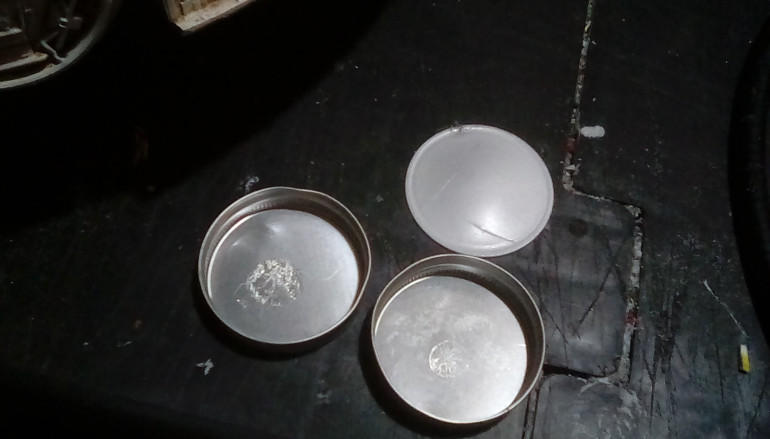 I find 2 round spice tub lids, that fit into the airlock perfectly. I use the circular inner seal as a.template for my card peices.
I find 2 round spice tub lids, that fit into the airlock perfectly. I use the circular inner seal as a.template for my card peices.Straws and toys
As the Millenium Falcon has many jury rigged repairs heaped on top of heath Robinson lash ups, it shouldn’t look too neat and tidy. I also don’t want too much unstructured cardboard left before painting, as it won’t look very realistic.
To simulate the ship’s many power conduits I use paper straws. But surely, draws are too fragile and easily crushed you are probably thinking….. Not when they are filled with hot glu e and allowed to set. I promise you, this project was not sponsored by a bit glue manufacturer – but when you are looking for a solution, and happen to have a bit glue gun in your hand….
A word of caution though. Hot glue is, well, very hot, and it needs to be very hot to run down into a straw. If doing this don’t let the glue run straightening through the straw and out onto your tender skin, as it will cause blisters, welts or worse. It can be advisable to use tweezers to hold the straws!
It is best to mitre the joints sure the straws meet as closely as posible. Any gaps can be covered by making a sleeve – just cut a straw lengthwise, but it to shape, then glue it over the original straws. It should just pop on, like miniature pipe lagging.
I continue adding straws, as well as s some parts cut from cheap plastic toys bought from a pound store for this purpose. Also left over bits from the original toy spaceship are repurposed and stuck in place to add details. I have to careful to not block any walkways, while trying to make the ship look as cluttered and messy as possible. So, lots of straws in corners where they won’t interfere with miniatures on circular bases, but none where they would narrow corrridors too much.
All this adds details and texture to the surfaces that should make my painting and drybrushing look much better – Grey card is a great building material, but it doesn’t look particularly great painted so it has to be covered with other texture before priming.
Some of the horizontal straws are placed to give added support to the roof in places where it was just floating without support previously. It was only when I started adding these that realised how important they would be to make the roof nice and firm when on top of the ship.
Starting on the internal rooms
Now I start on the most important part of this build for wargaming – building the internal rooms. If the ship is too open-planned there is no interest in the terrain – without cover it is just mini’s shooting at each other. I’m envisioning cat and mouse games of infantry miniatures sneaking around the ship and taking shots when they can, so I need rooms that aren’t just dead ends with different ways in and out. And on top of that, I want it to contain the elements I remember from watching star wars as a kid.
It is impossible to make the actual layout of the Millenium Falcon – the outside hull props and internal sets were built for the films were different sizes – the rooms literally are too big to fit inside the smaller hull.
I build the rooms walls using a similar method to how I levelled the floors – a card framework covered in grey card and filled with lightweight filler.
Revisiting the rebuilt hull
I wasn’t happy with how the re-built hull (where the nerf gun used to be in the ship) tuned out. I picked up some styrene stips from my local model shop (I can’t call them tubes as they ‘re rectangular in cross section – but you get the idea) and glued these on, removing any excess grey card with a sharp knife. Note I used superglue – not glue would have just melted the styrene. I glued on some metal wire, making sure these joined up with some of the “wiring” moulded into the rest of the plastic hull, to pull the two areas together.
Painting this rebuilt area to match the rest of the ship proved problematic. I painted the new wife and styrene with white primer, then repeated the stages I had used previously to paint rest of the ship. The wire blended in ok, but the styrene was too flat and smooth for drybrushing to work well in it – in the end I stippled on sepia shade and then once this was dry stippled on the lighter colours instead of drybushing. It’s Not a perfect match for the previous colours, but no doubt I will be tweaking that but of painting as I go on to try to make the match close hit
I hit some panels of the hull with light grey, to lower the intensity of some of the Sepia shade and appease any star-wars-grognars who think the ship should be grey (I think the falcon is really white and just discoloured by whatever dirt and grime is costing it currently- I’ve been aiming for a dirty off white).
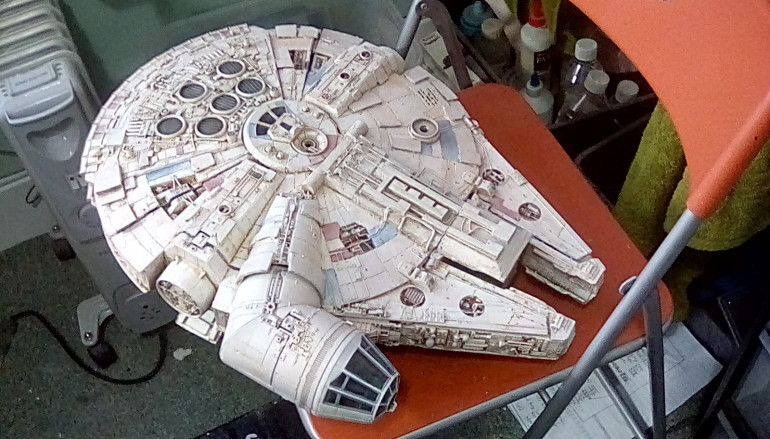 Subtly Drybrushed and blended with white grey, to knock back the Sepia tone on the top hull slightly.
Subtly Drybrushed and blended with white grey, to knock back the Sepia tone on the top hull slightly.Finally, I add soot trails behind the circular heat vents using my airbrush. I’m not sure why soot would not just blow out into the vacuum of space, but it’s part of the iconic look of Han’s ship. That’s the first time I’ve used an airbrush on this model.
The Cockpit
If I was making a diorama, then I would sculpt chairs for the cockpit, and reposition some minis so they were sitting in them. But I am making wargame terrain,for upright minis on 27mm bases. I envision scenarios where the falcon can only take off once 2 figures are in the cockpit to fly the ship. So essentially I am going to make a movement tray to fit in the cockpit.
 Holes for the miniatures based are drilled out with a 25mm drill. Unfortunately Legion infantry bases are 27mm, so I have to make the holes bigger with a half round wood file.
Holes for the miniatures based are drilled out with a 25mm drill. Unfortunately Legion infantry bases are 27mm, so I have to make the holes bigger with a half round wood file.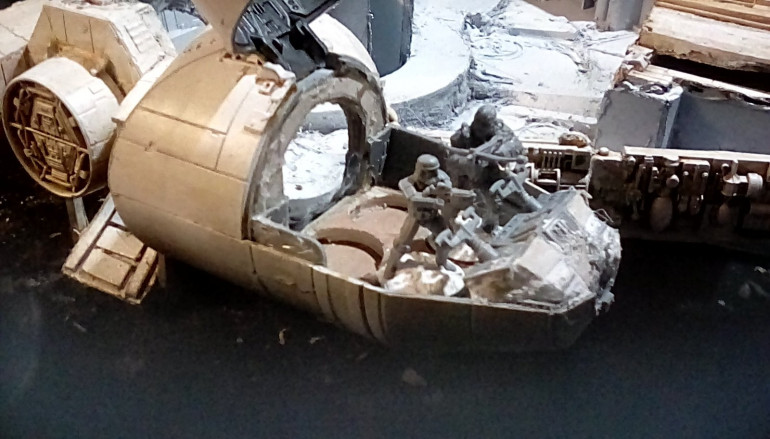 Pretty happy with this so far. An arch made from 3 layers of greyboard is glued in at the back, to make the doorway into the cockpit.
Pretty happy with this so far. An arch made from 3 layers of greyboard is glued in at the back, to make the doorway into the cockpit.Using the same technique I used earlier, I create a flat floor for the corridor to the cockpit and a step down to get to the central corridor. A frame made of grey card is glued in place, filled with lightweight filler, then topped with more Grey card.
The inside of the cockpit is primed blavk, Drybrushed mid-grey, then a few quick details added – a brown steering wheel, red and green indicators on The dashboard. The detailing is nowhere near finished, but I’ve got the structure of the cockpit in place. A bit more painting is done on the cockpit cannopy – bare plastic was left where I had to protect the clear perspex with masking tape when priming the rest of the hull.





























